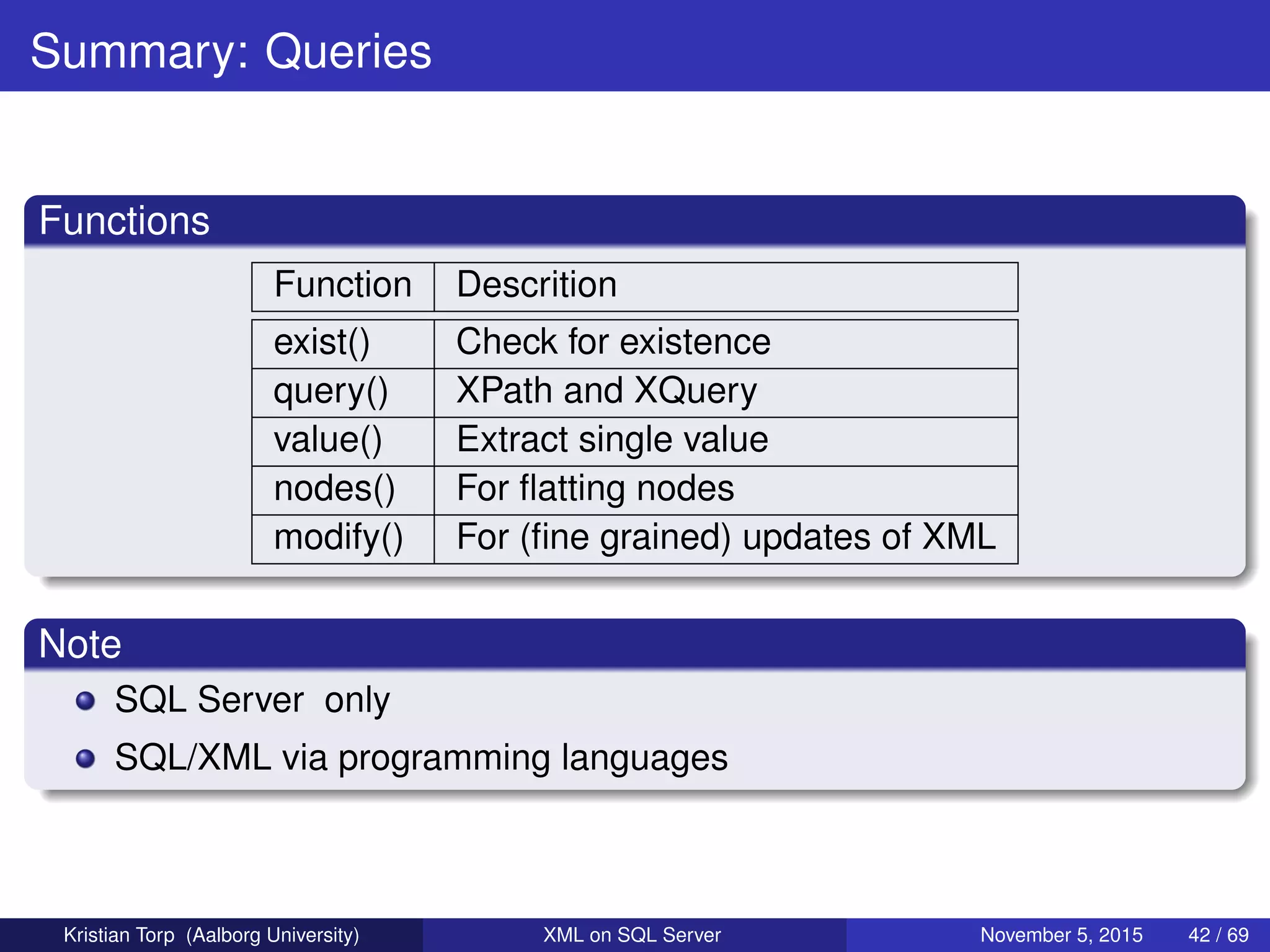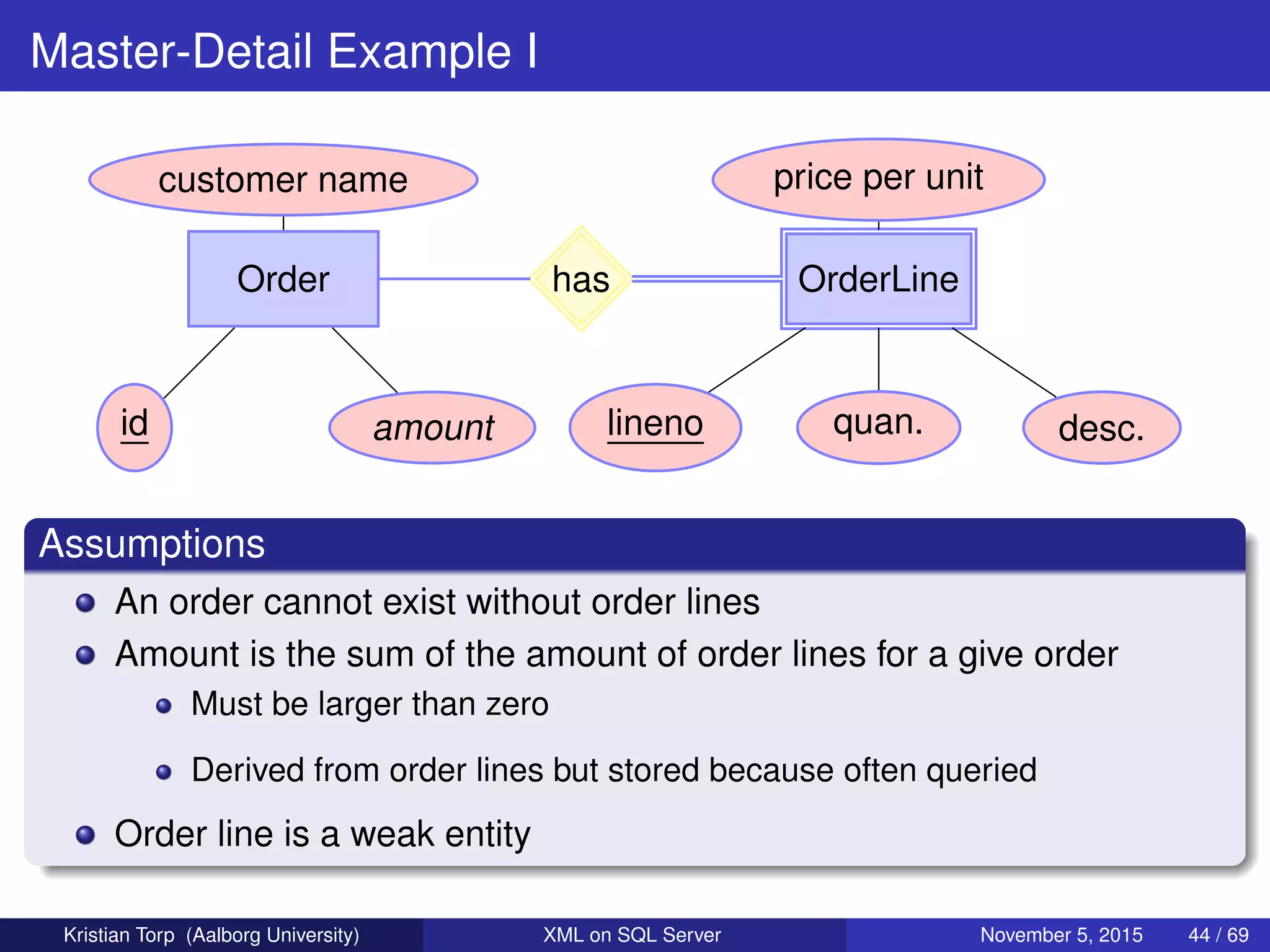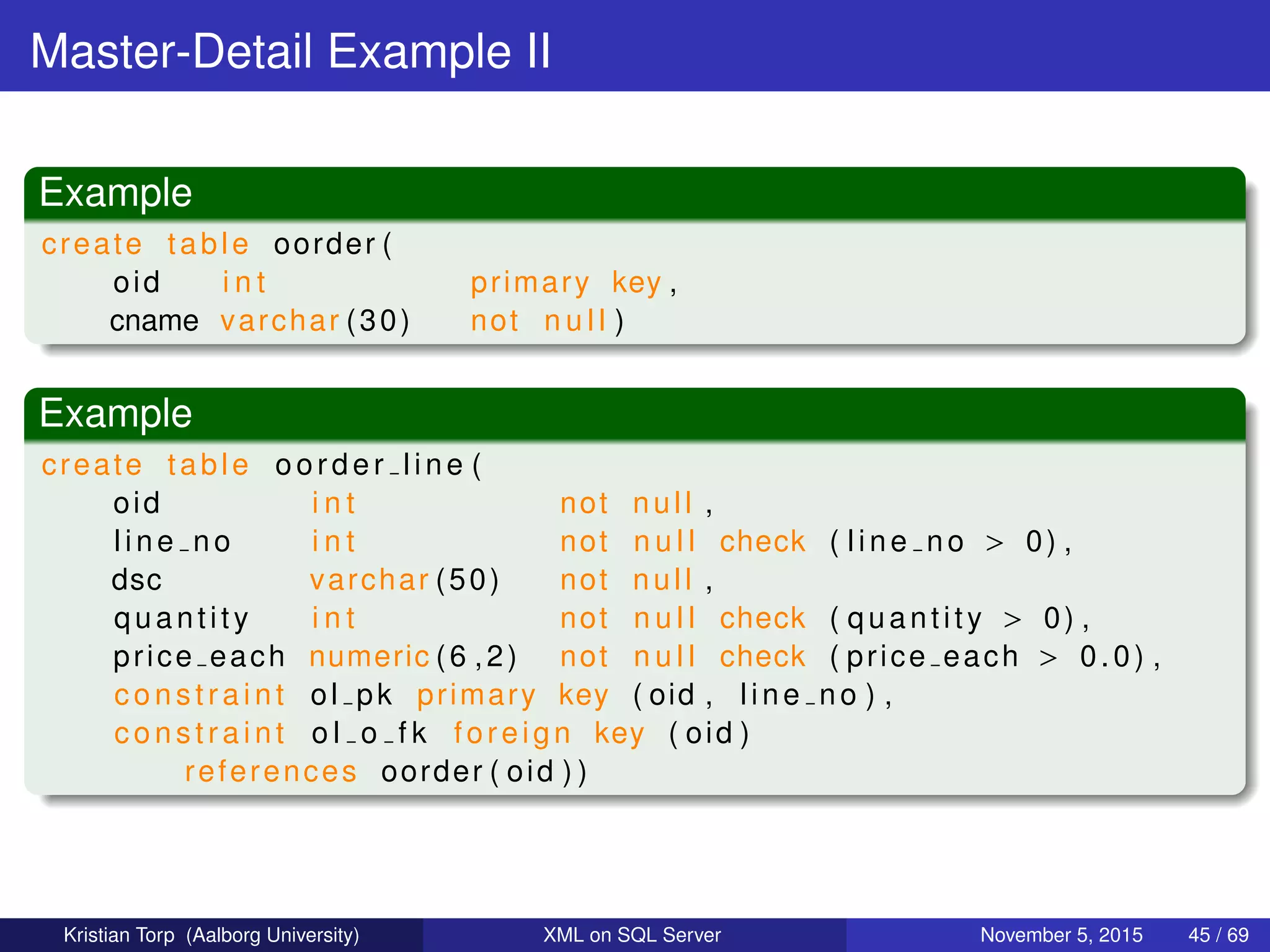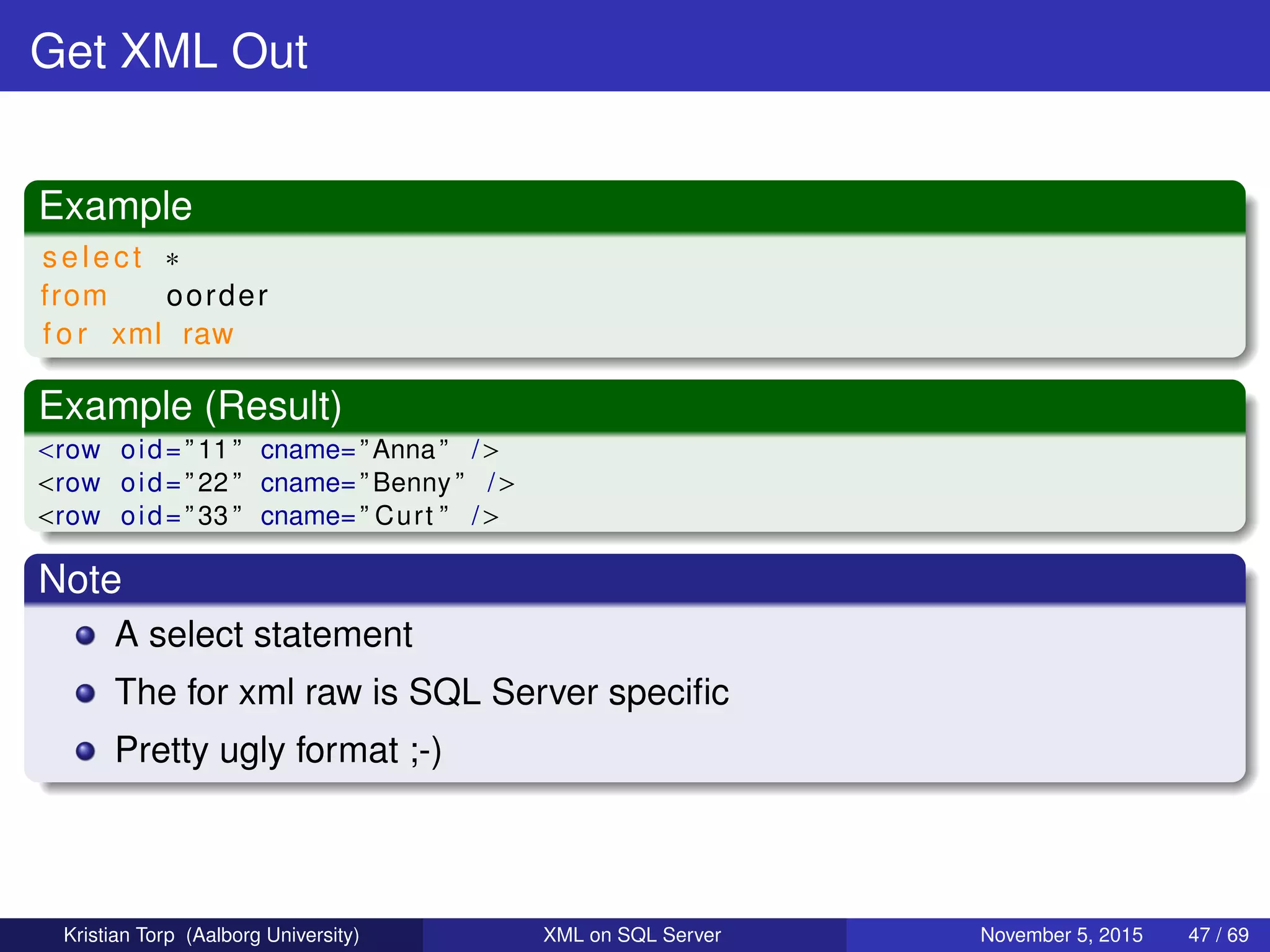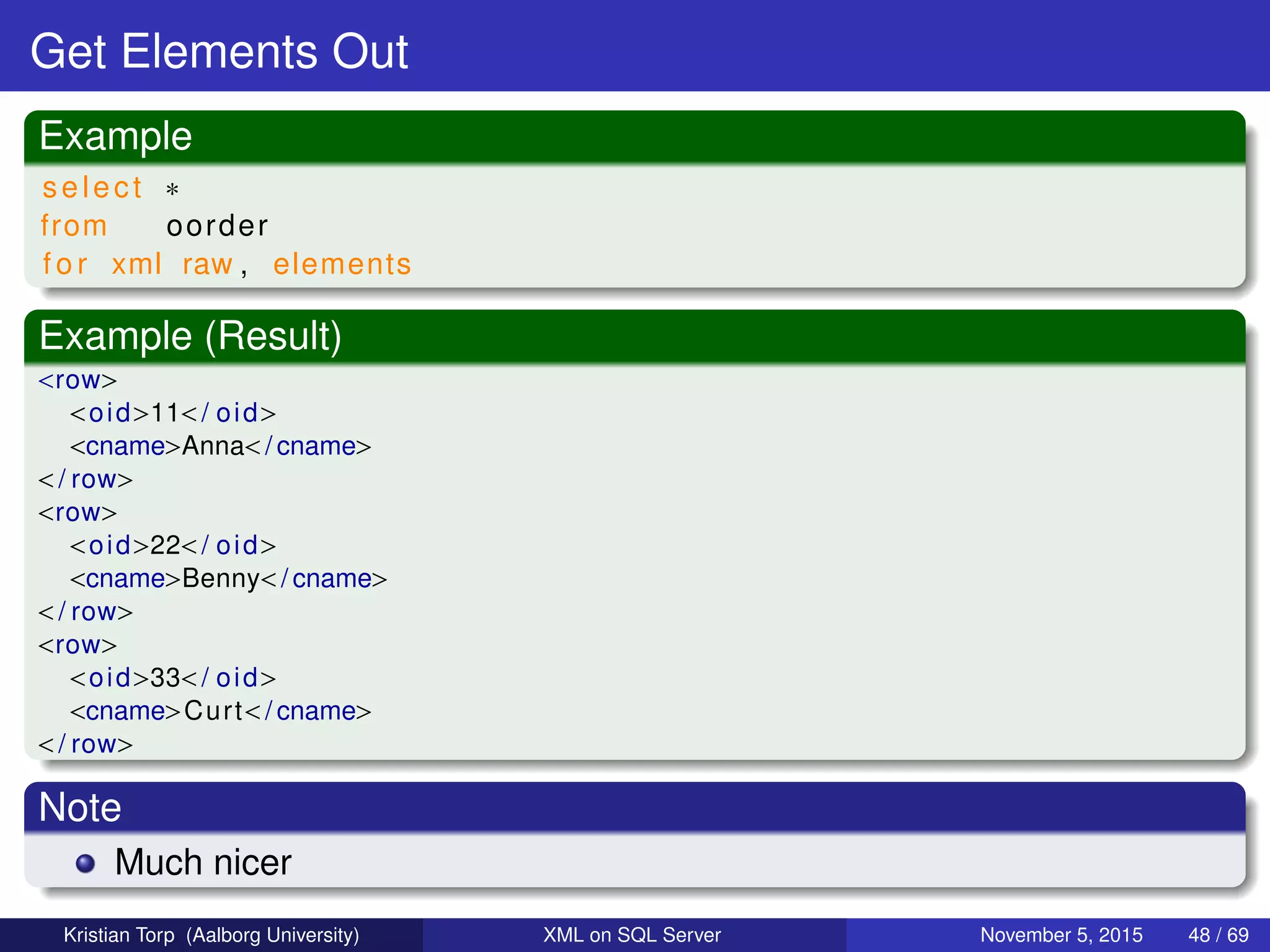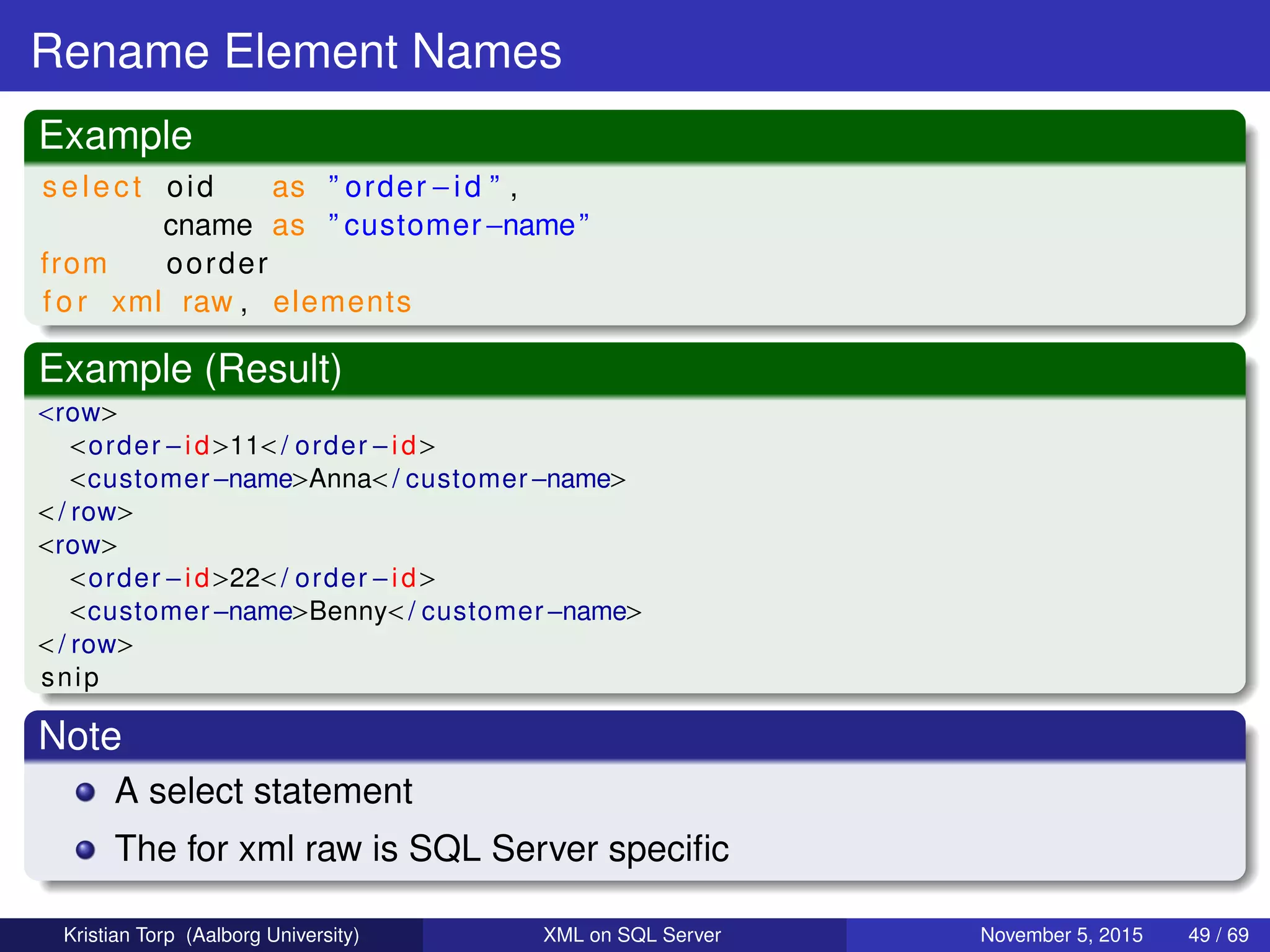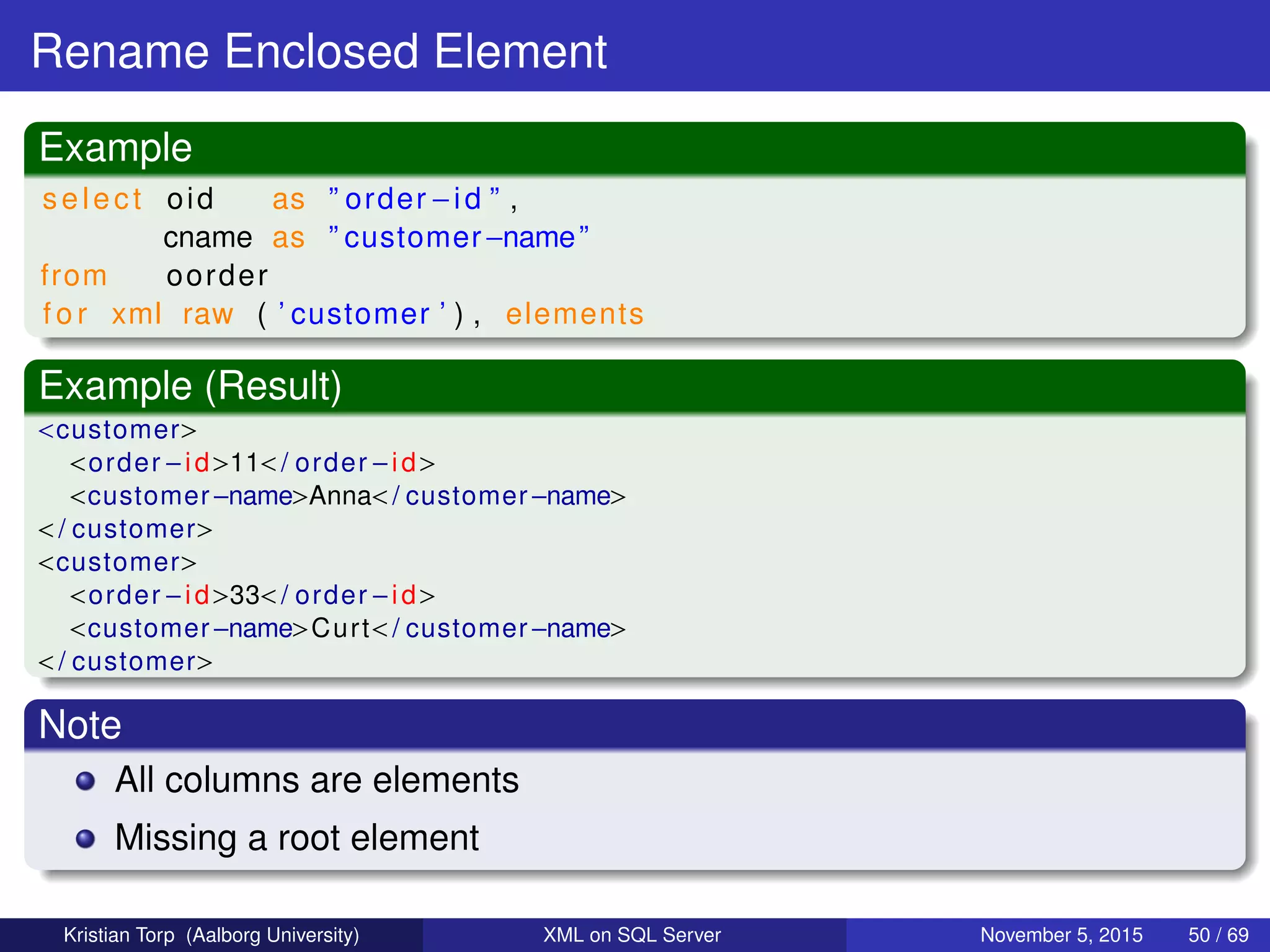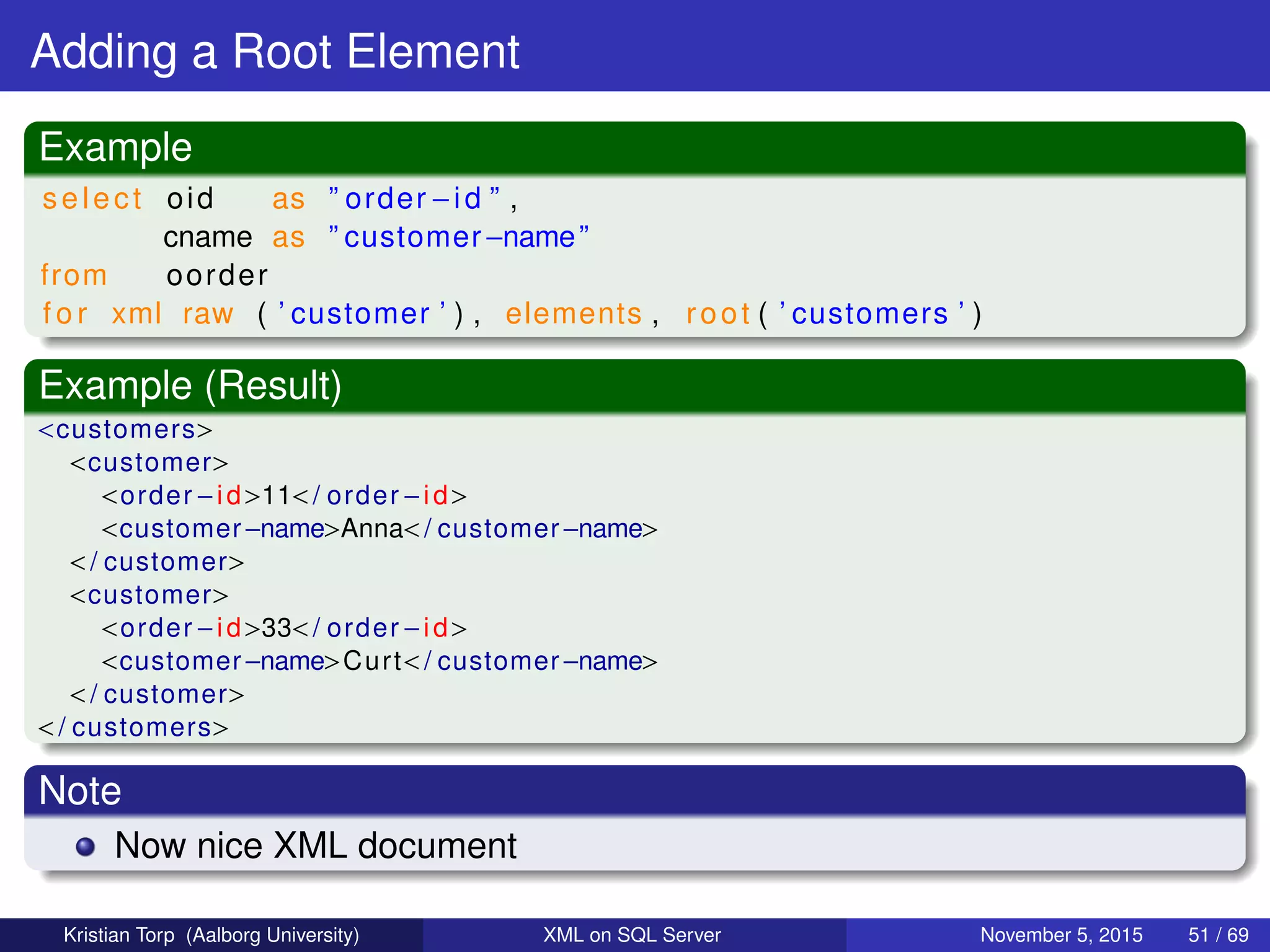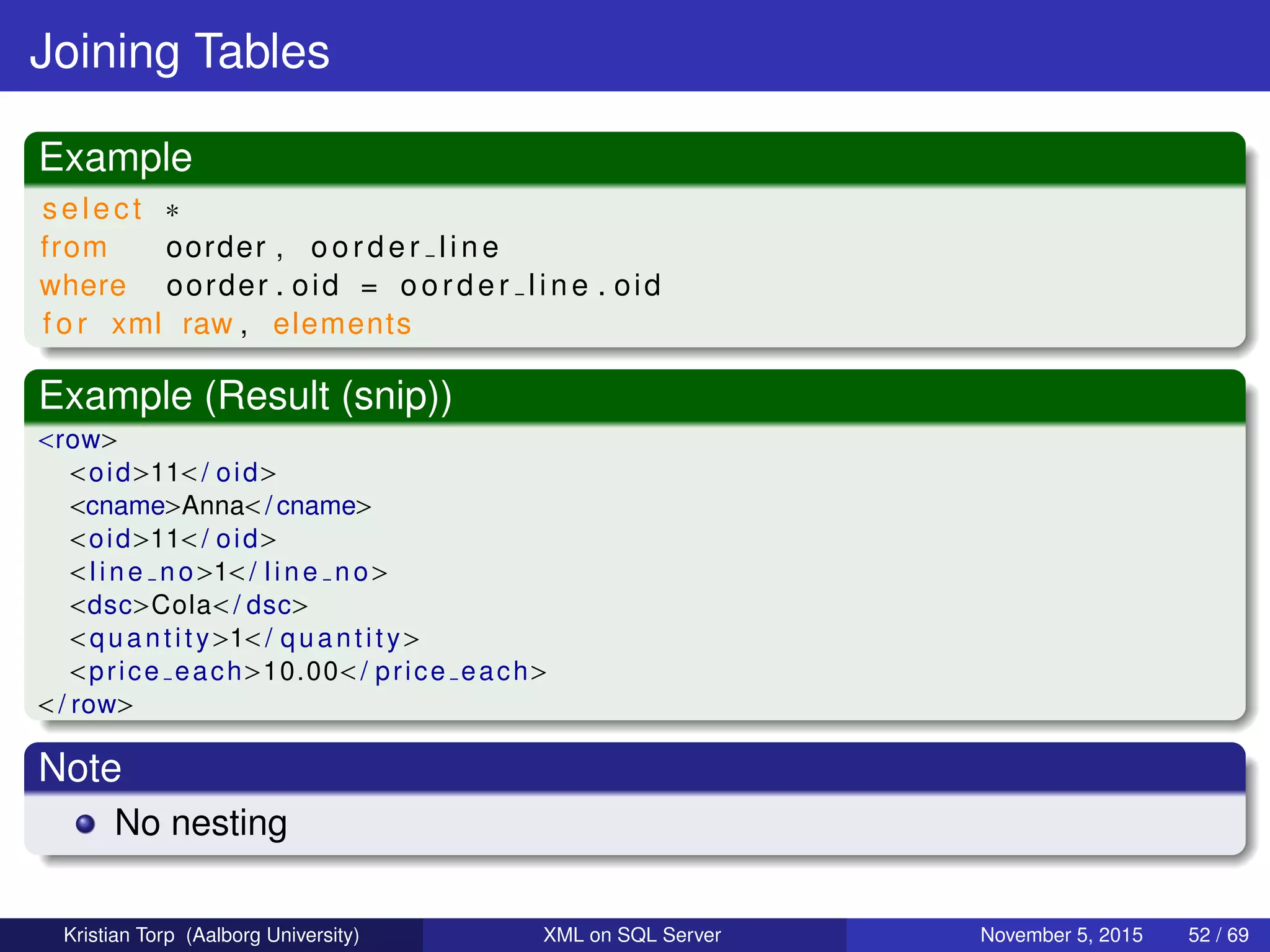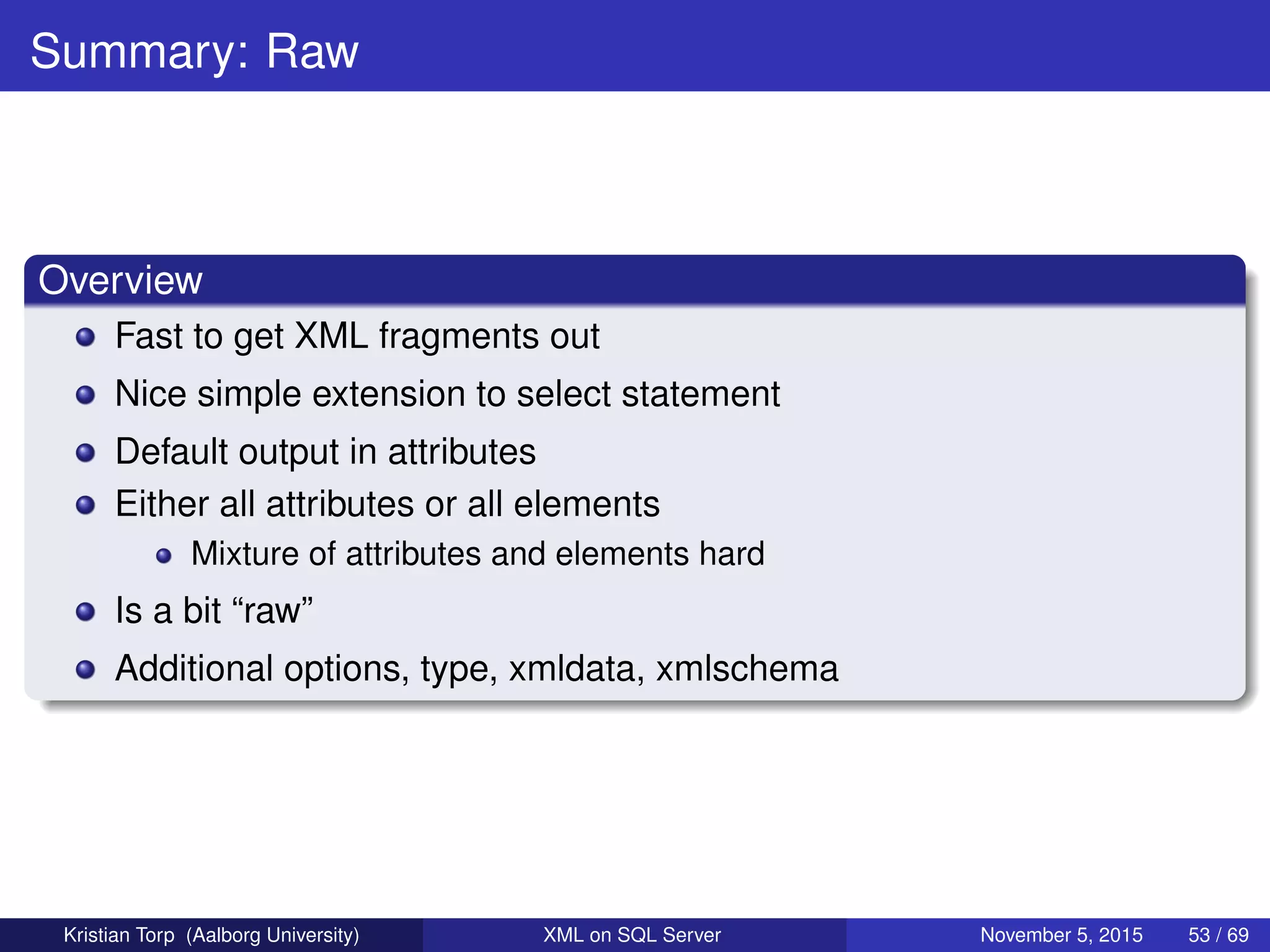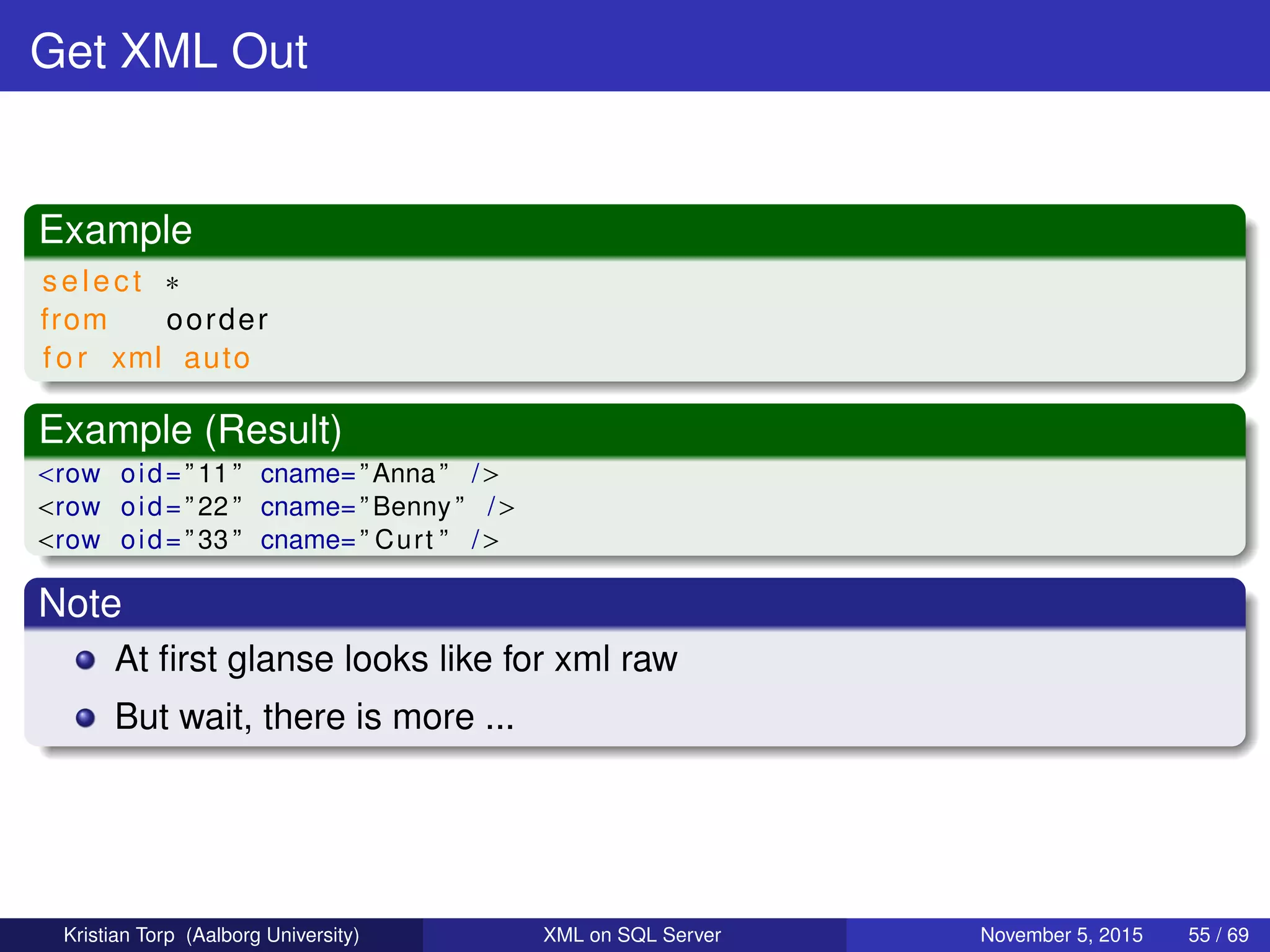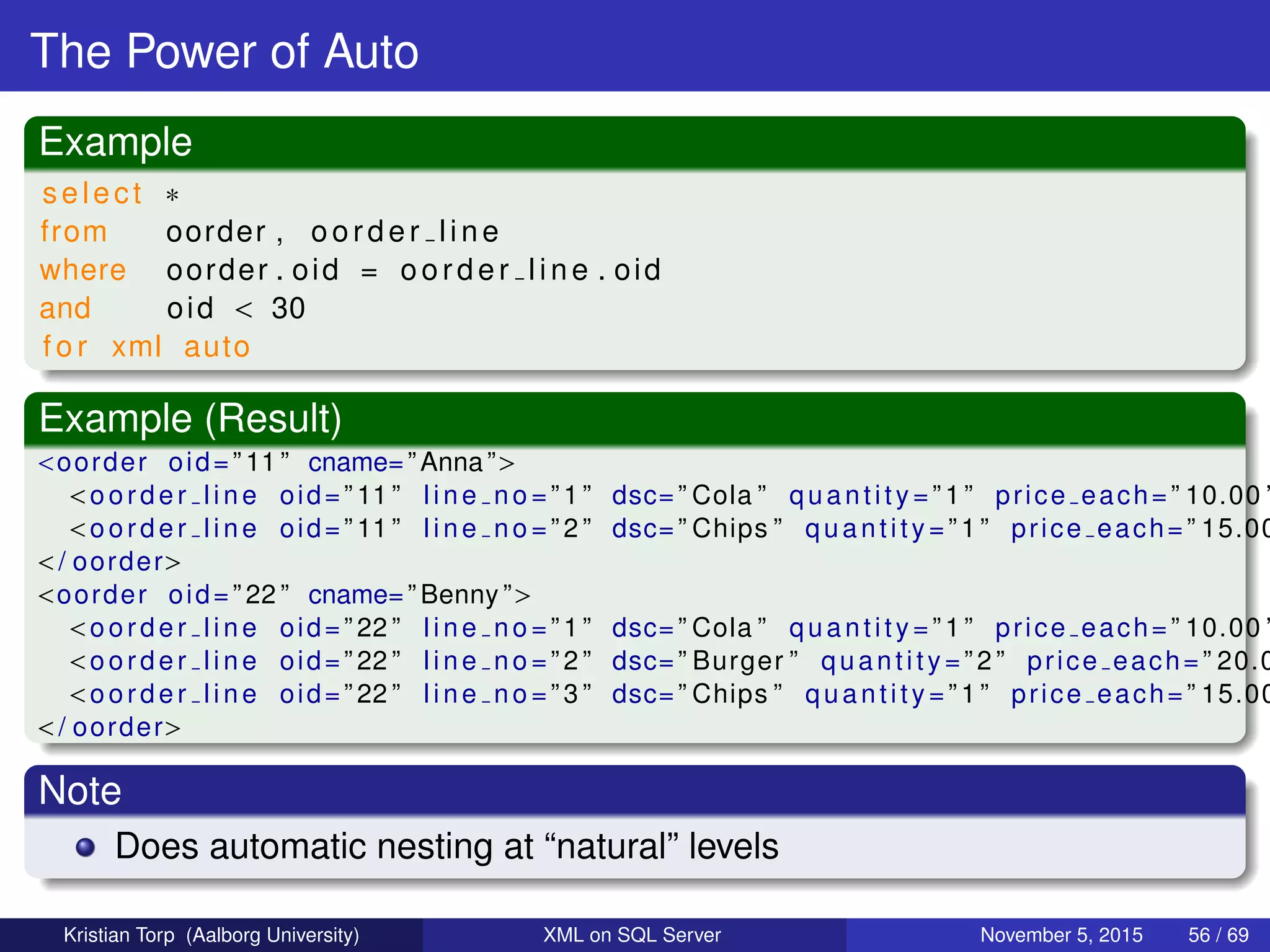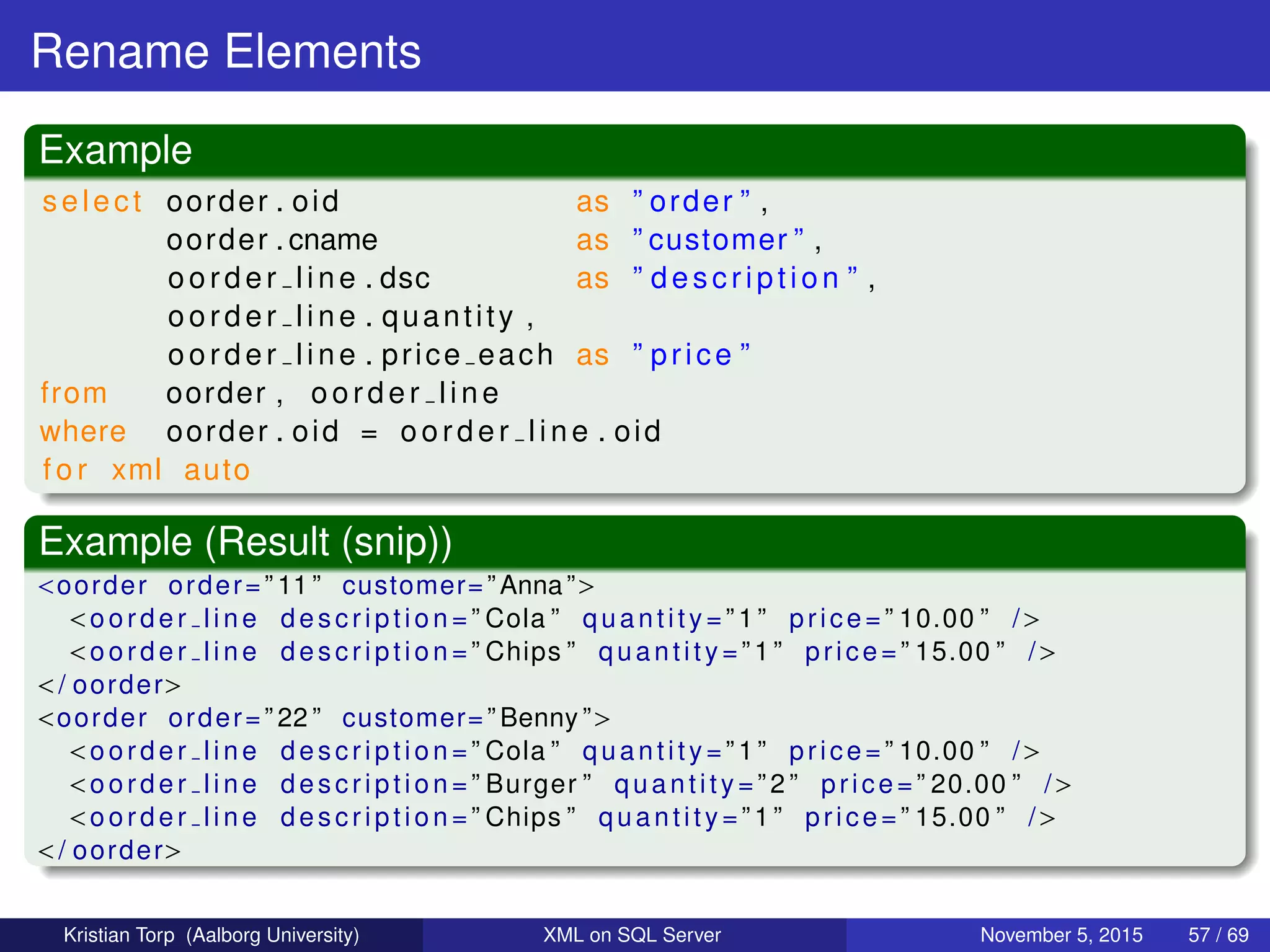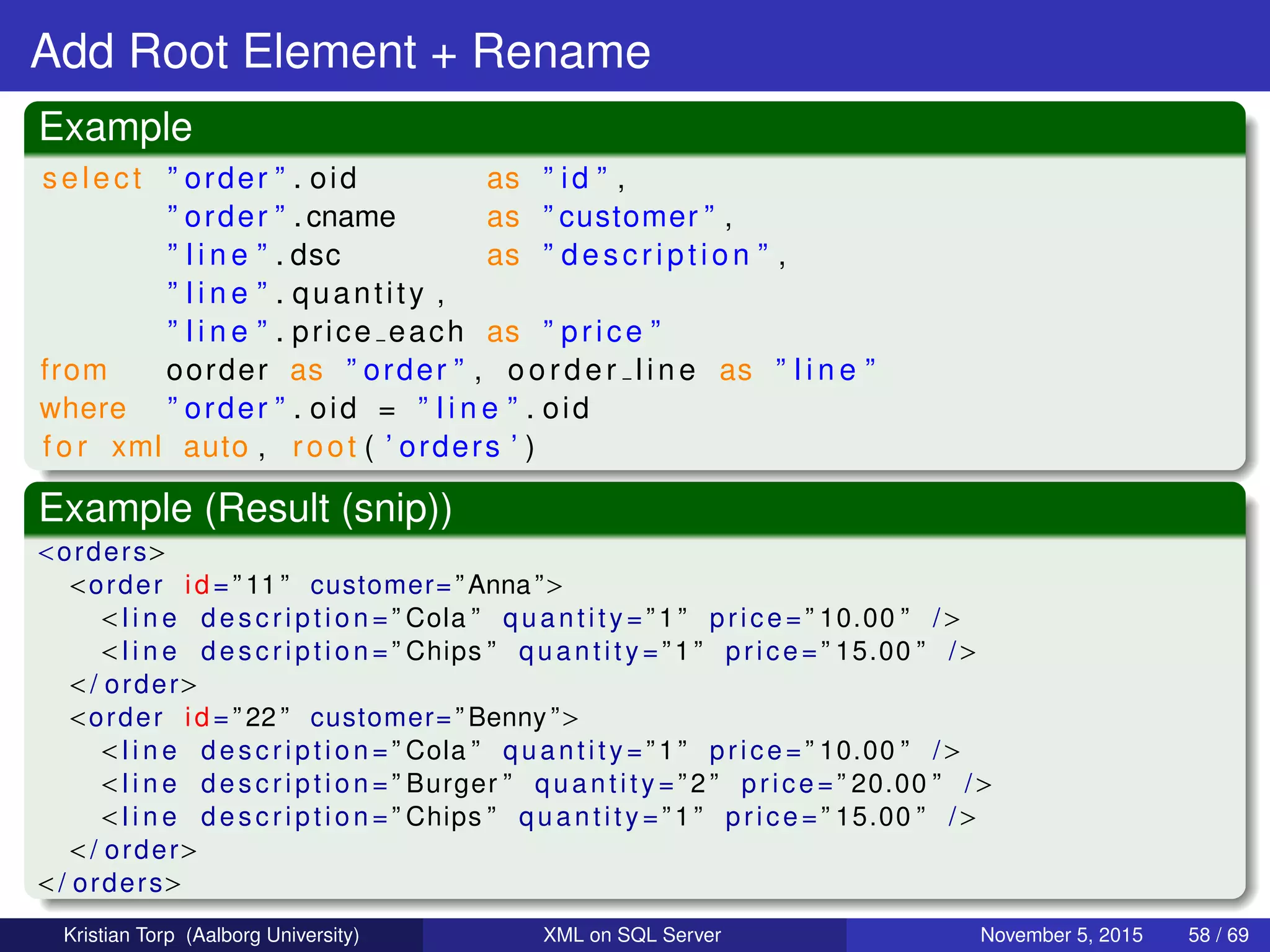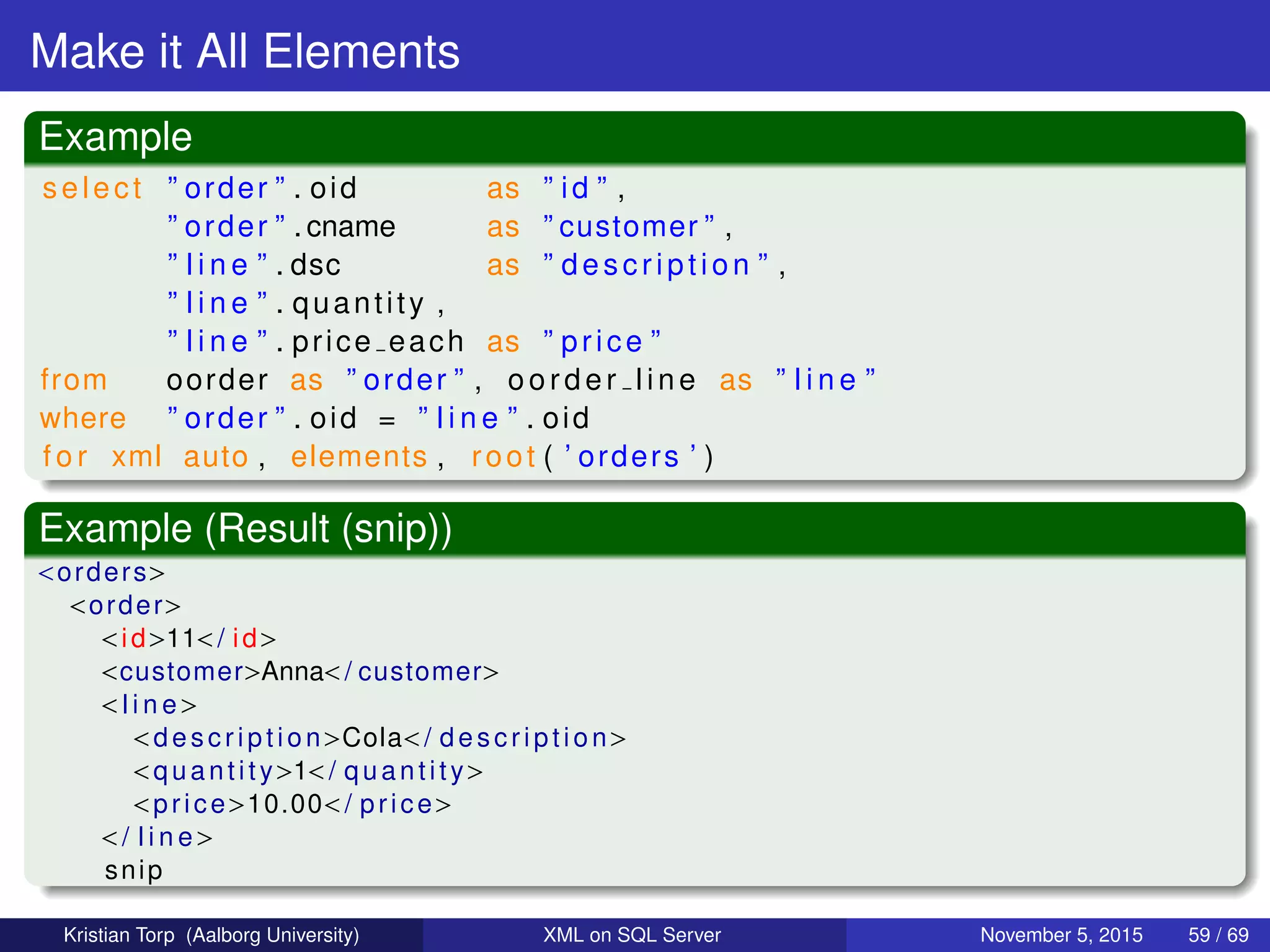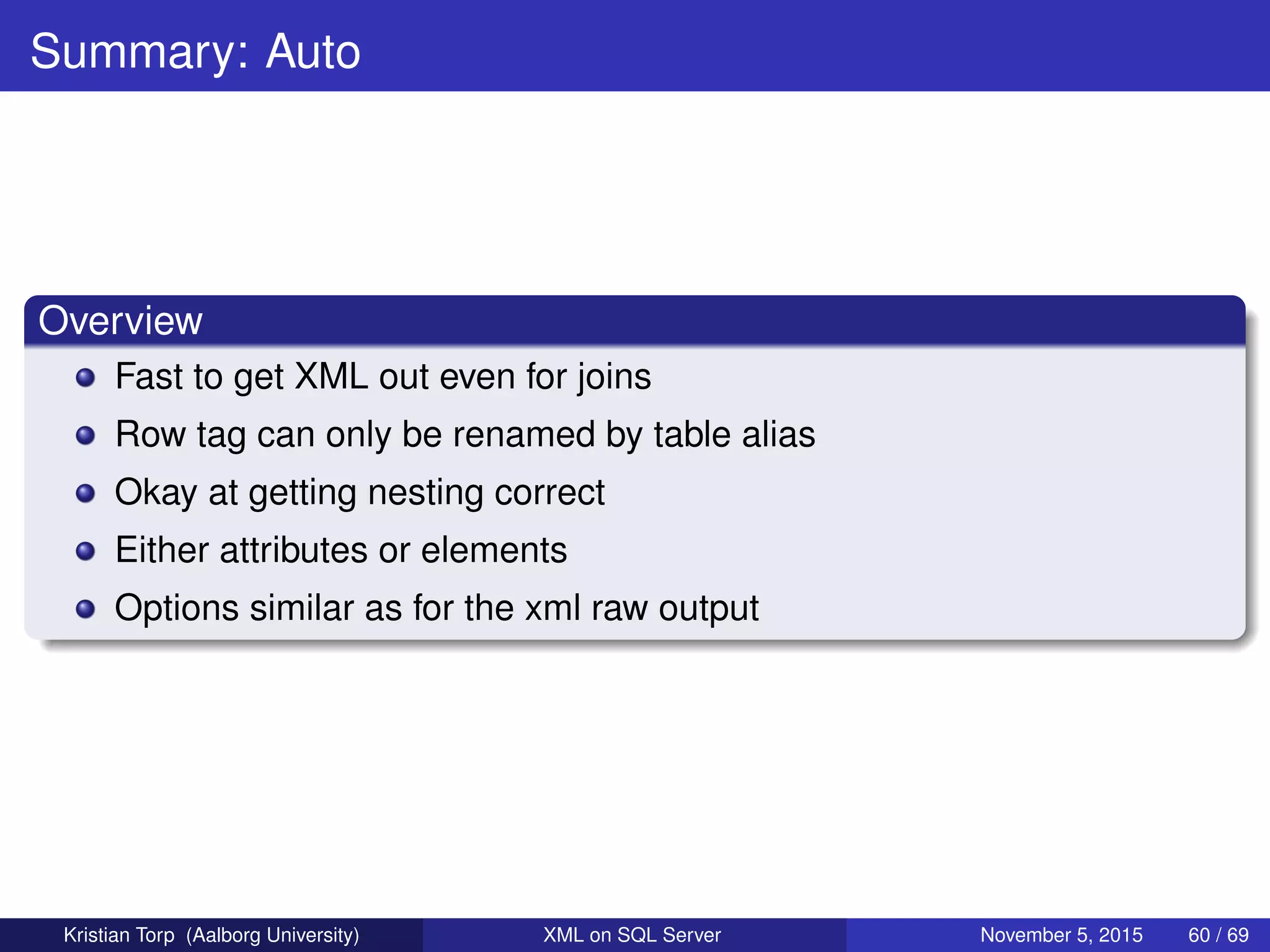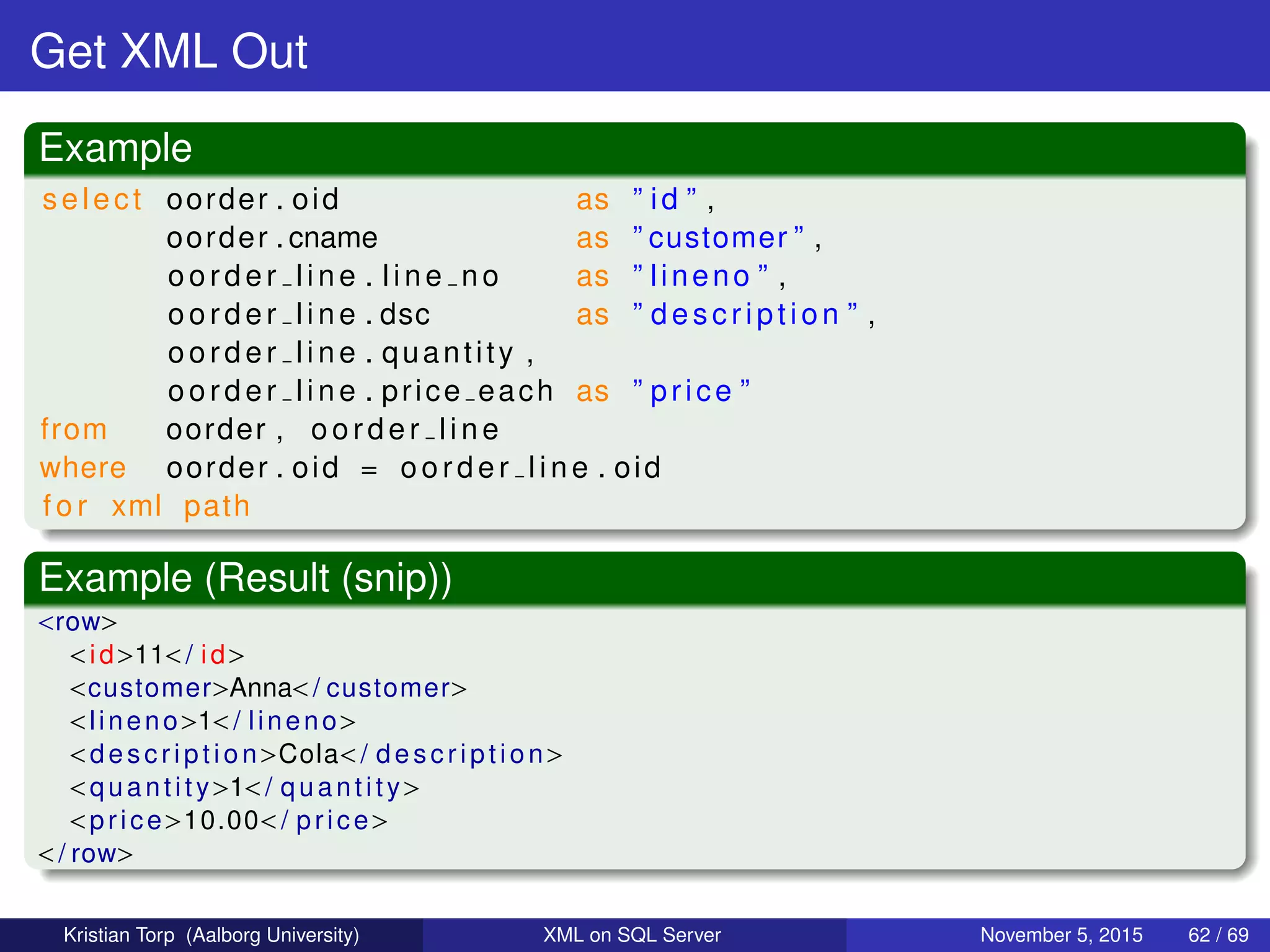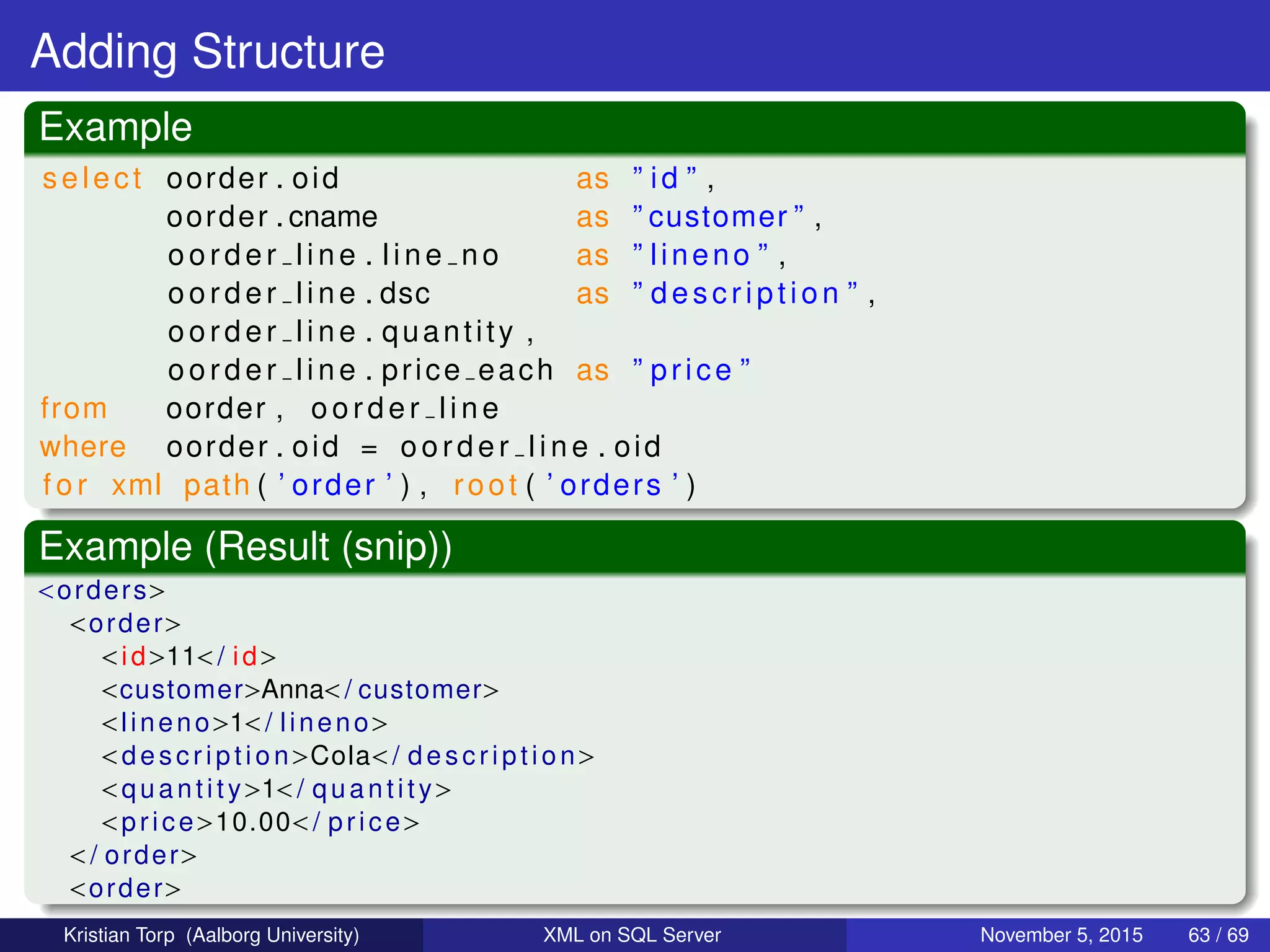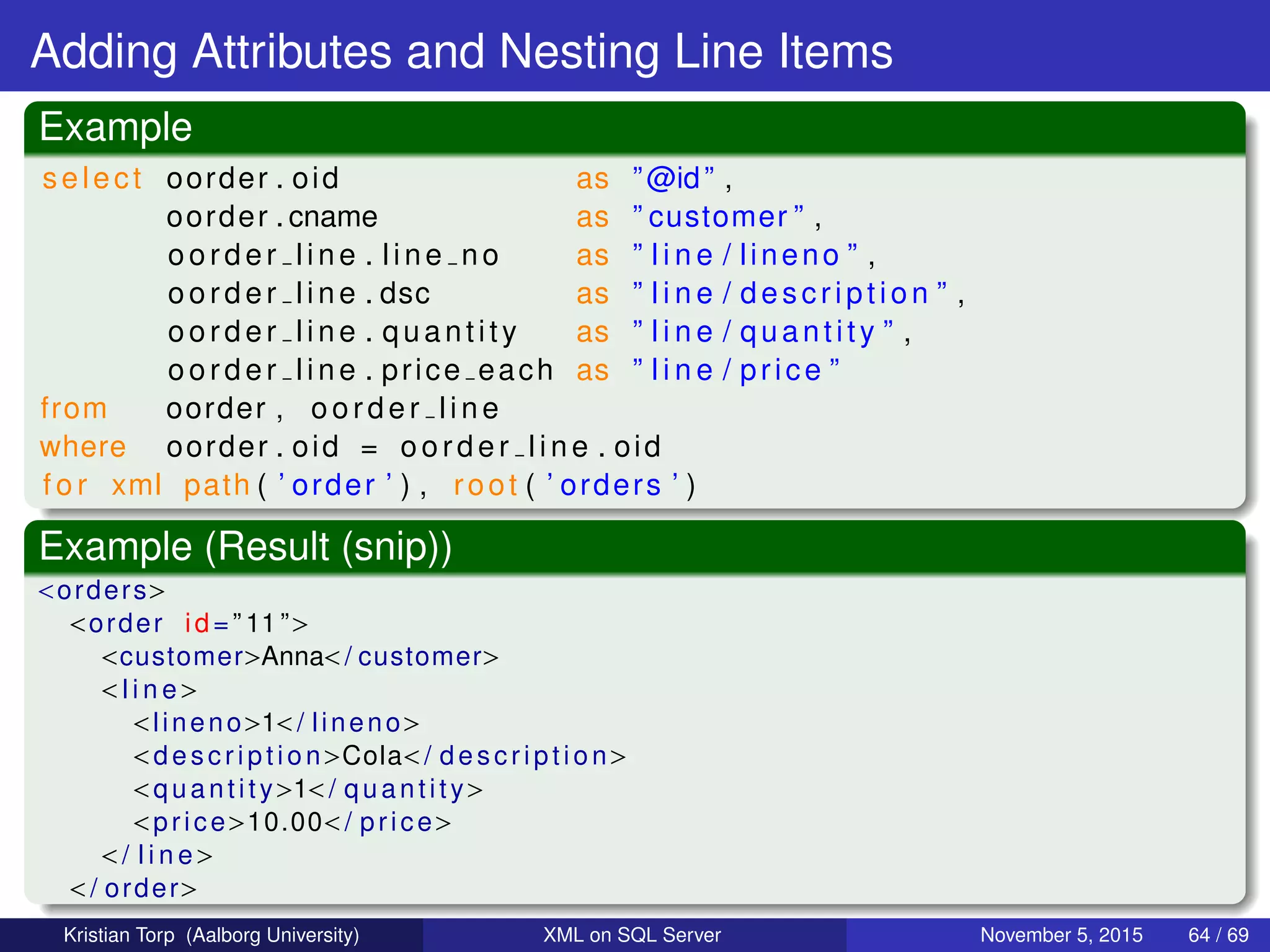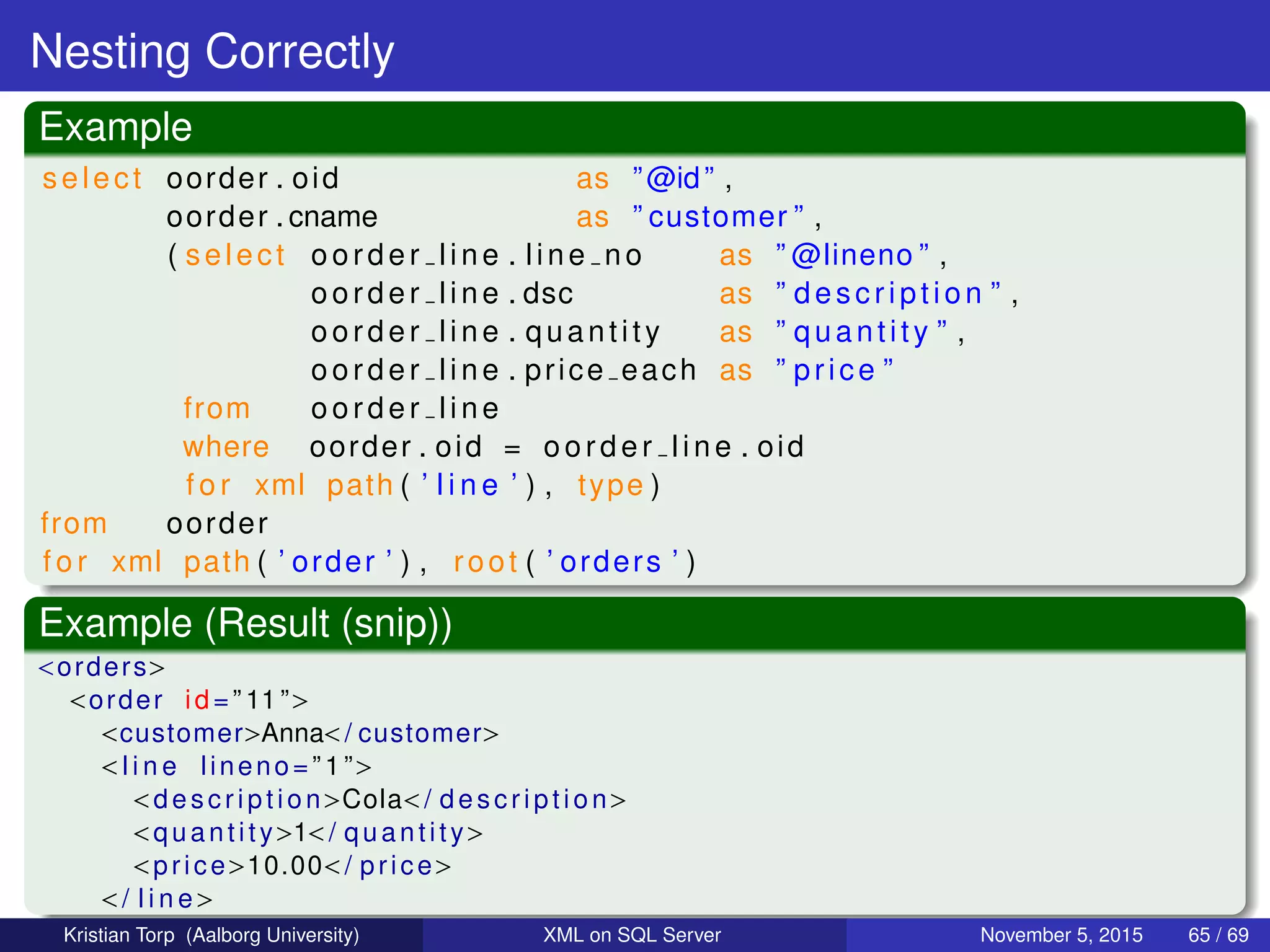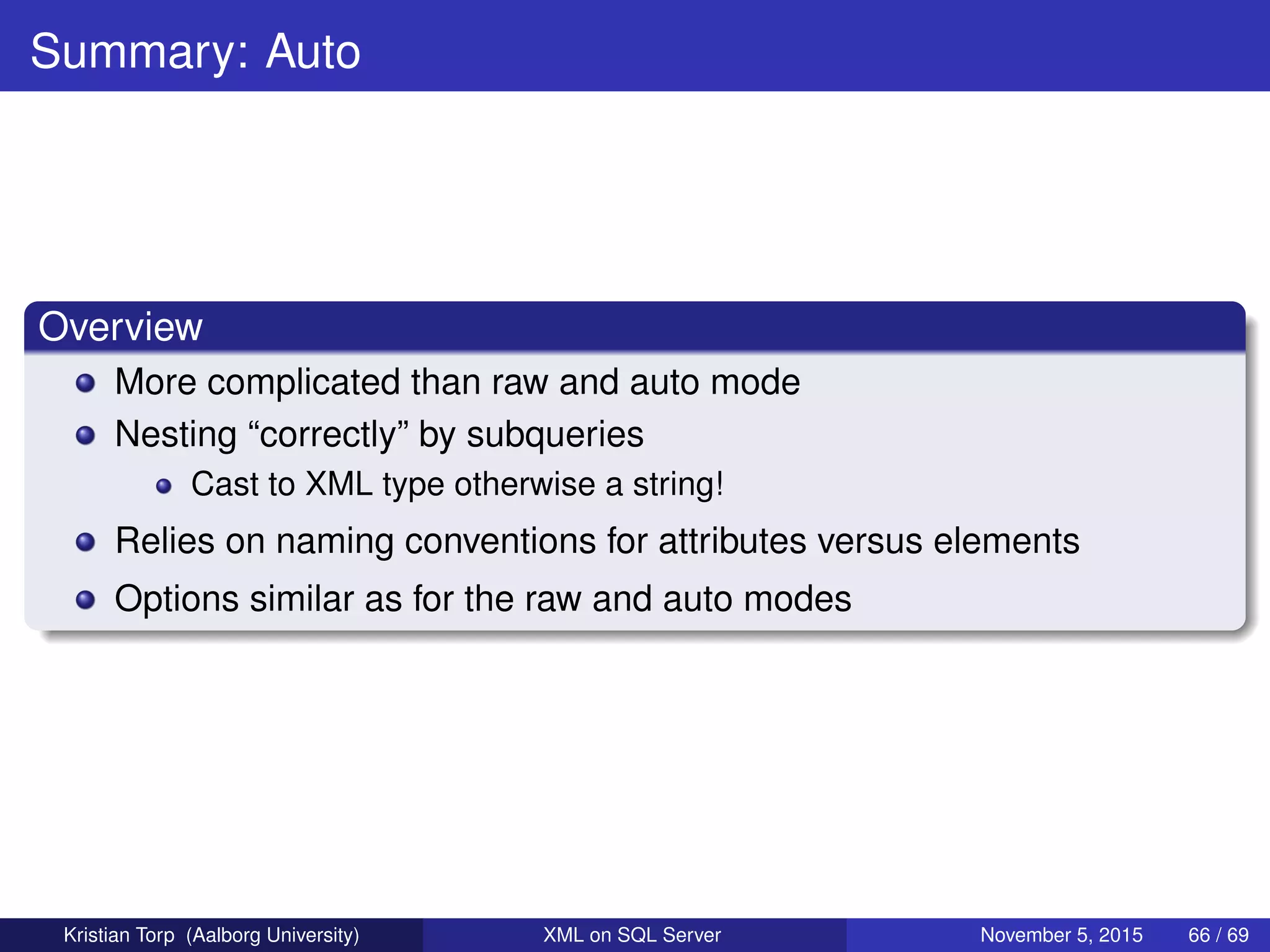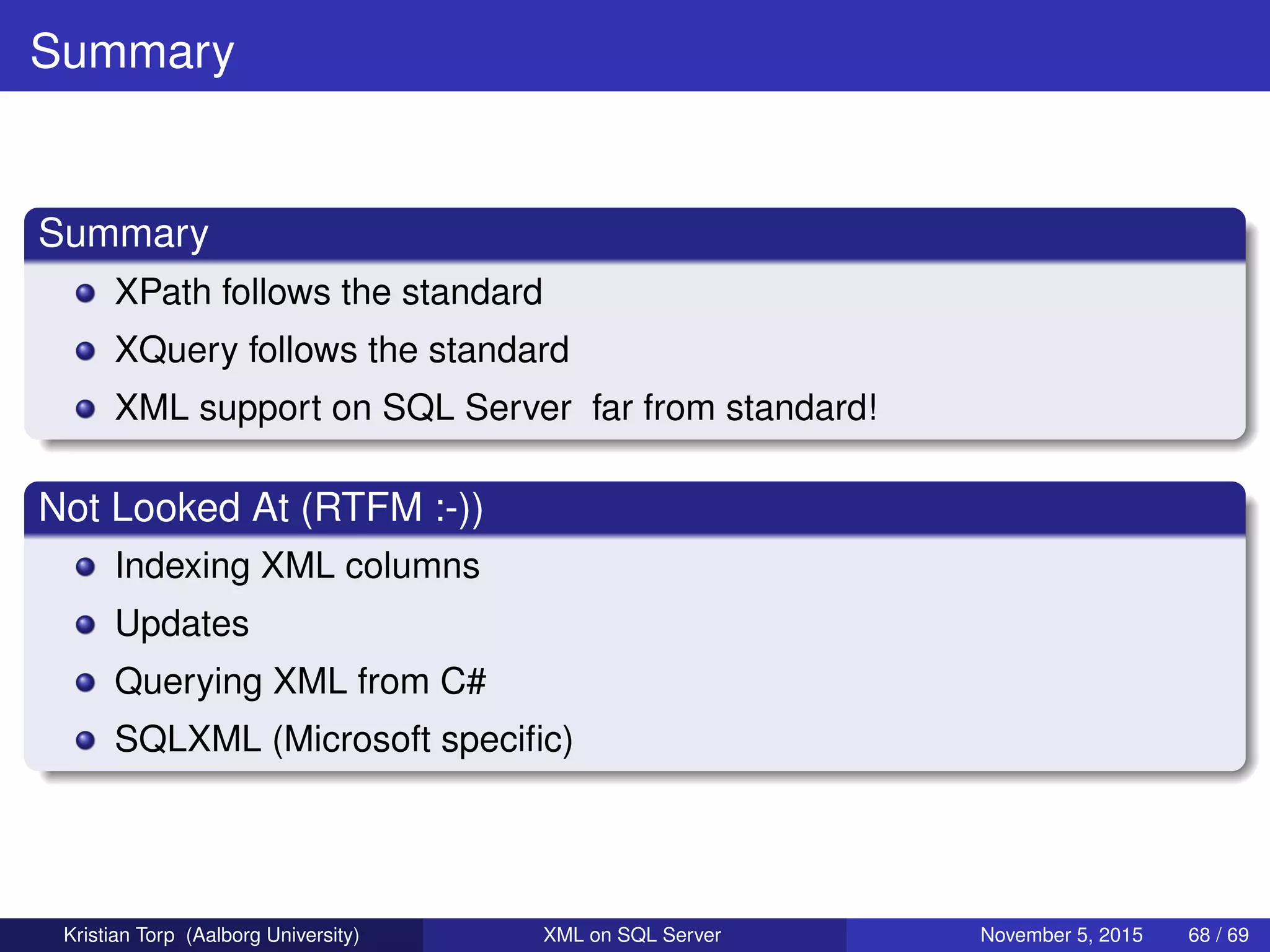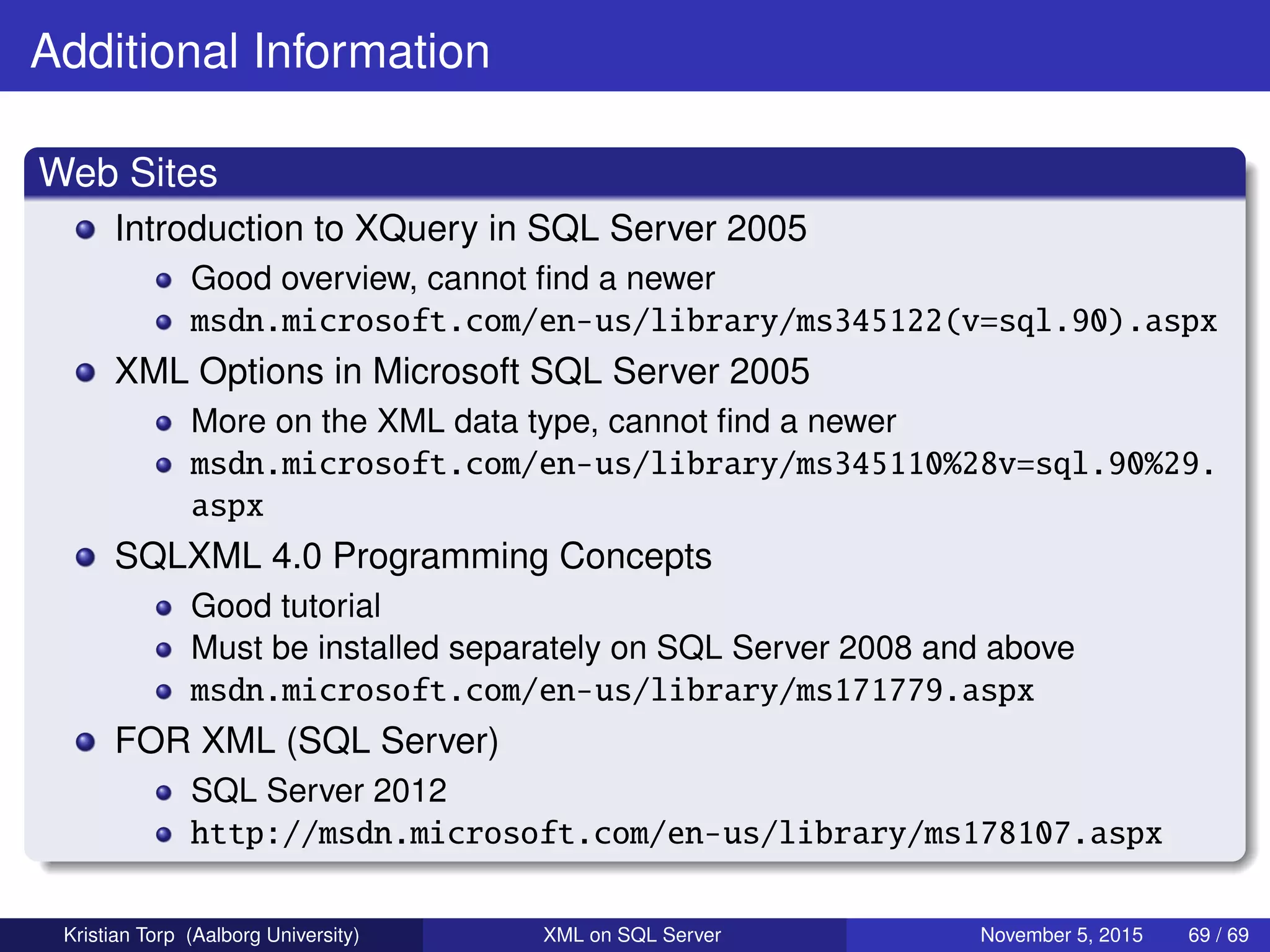The document discusses the integration of XML with SQL Server, detailing methods for creating and manipulating XML data using SQL queries. It covers schema creation, data insertion, querying techniques, and specifies issues related to XML formatting and the use of functions like exist() and value(). The content provides examples and insights into how XML data types are handled in SQL Server, particularly in the context of educational course information.
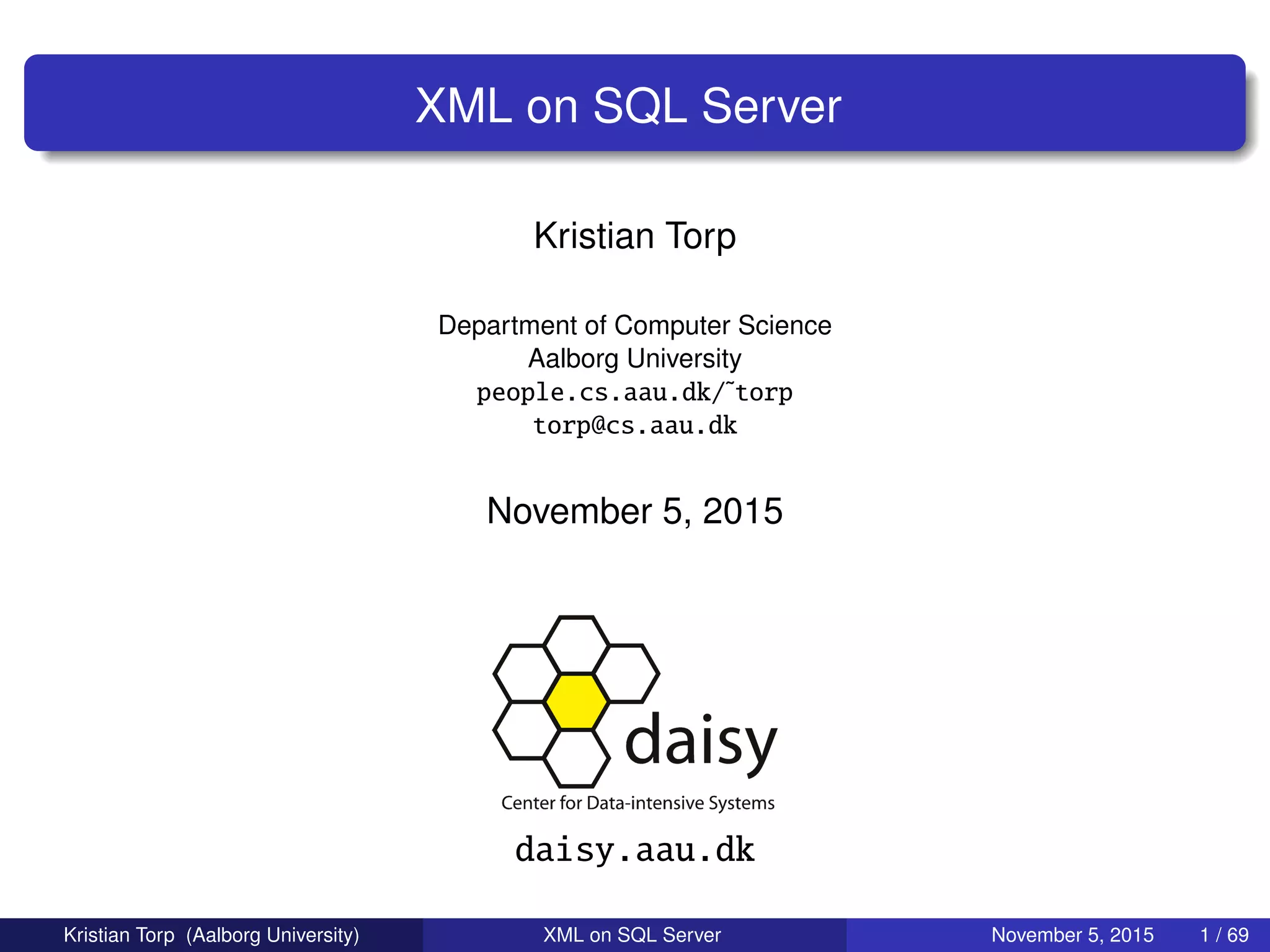
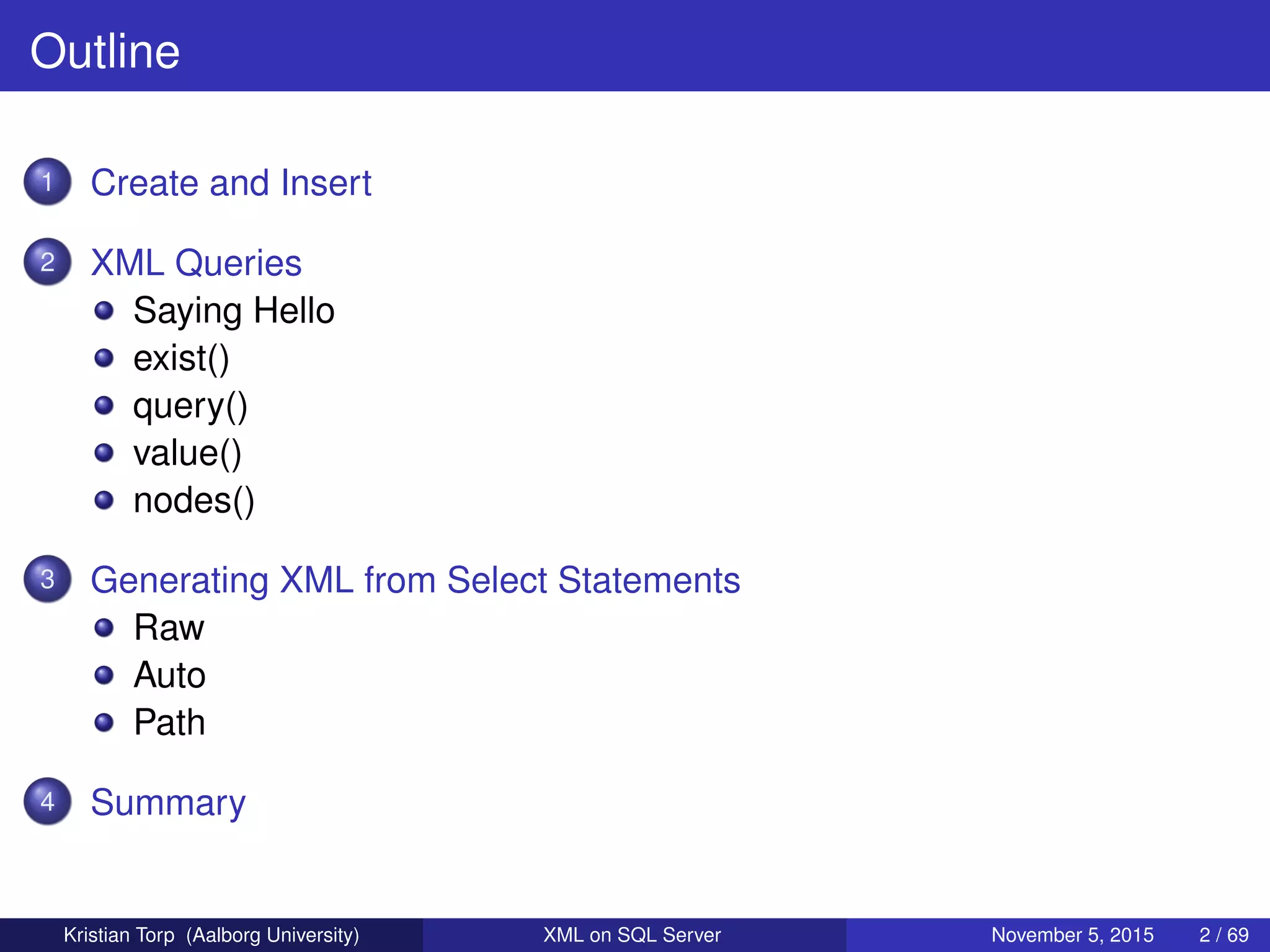
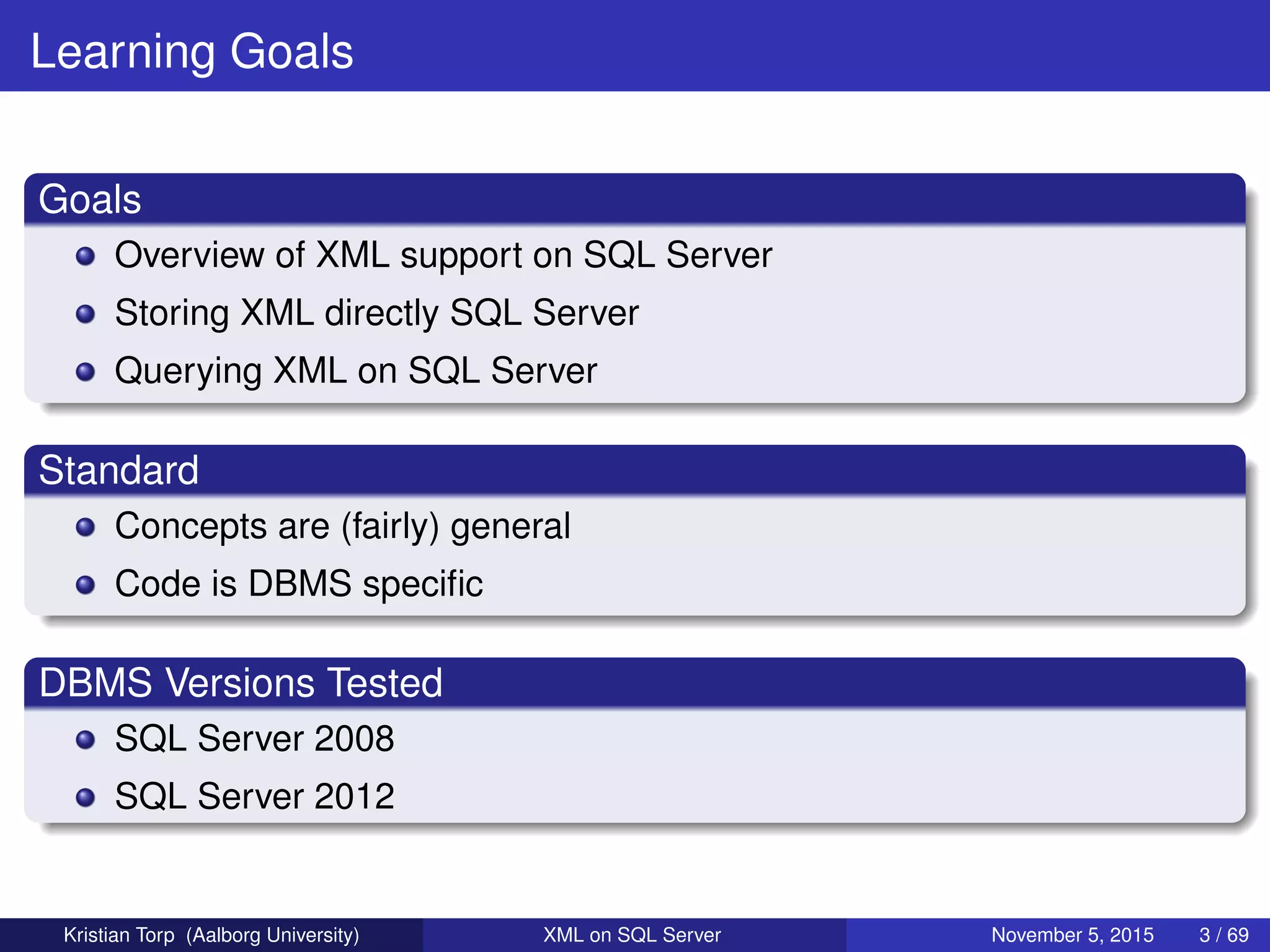
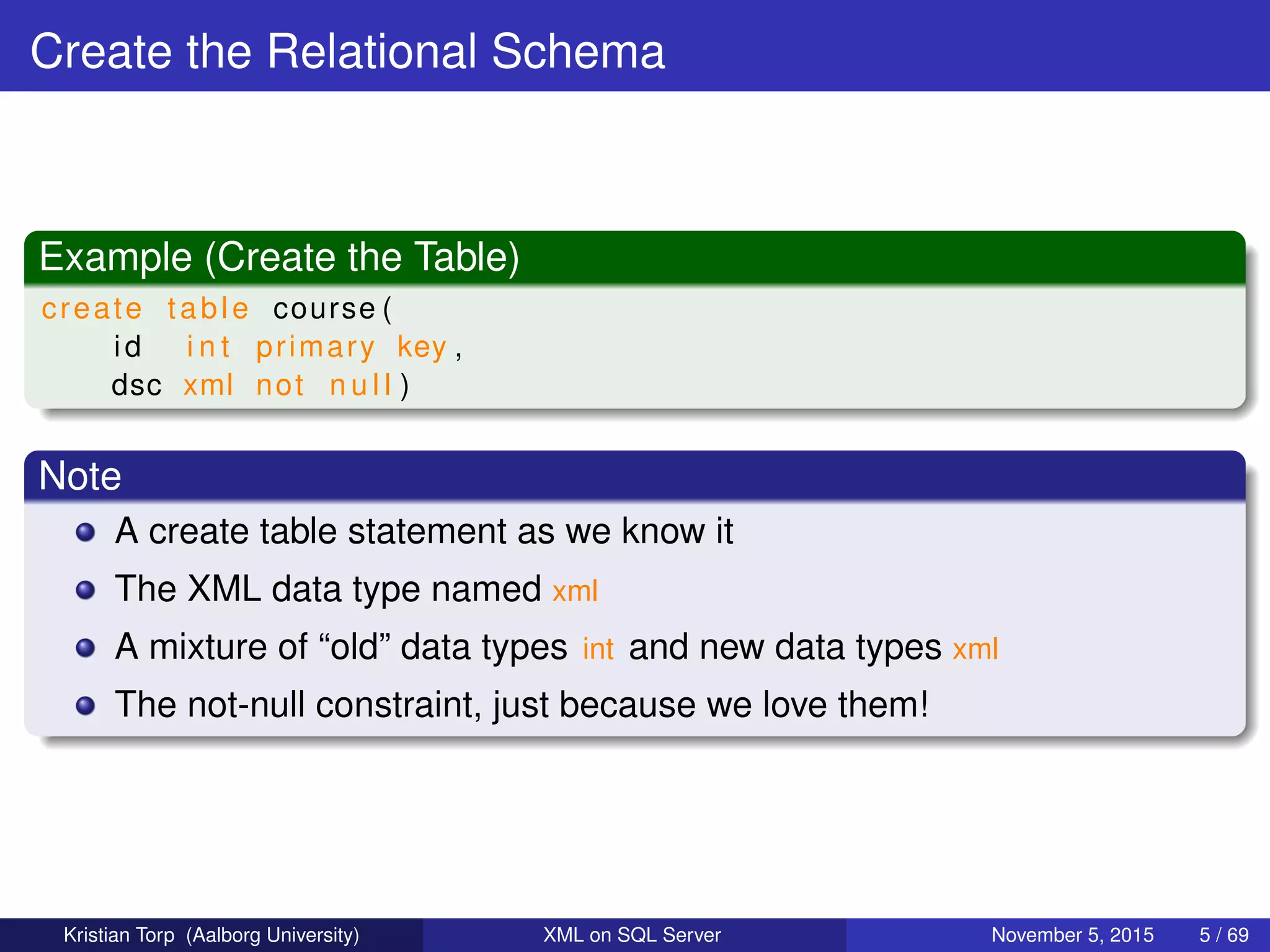
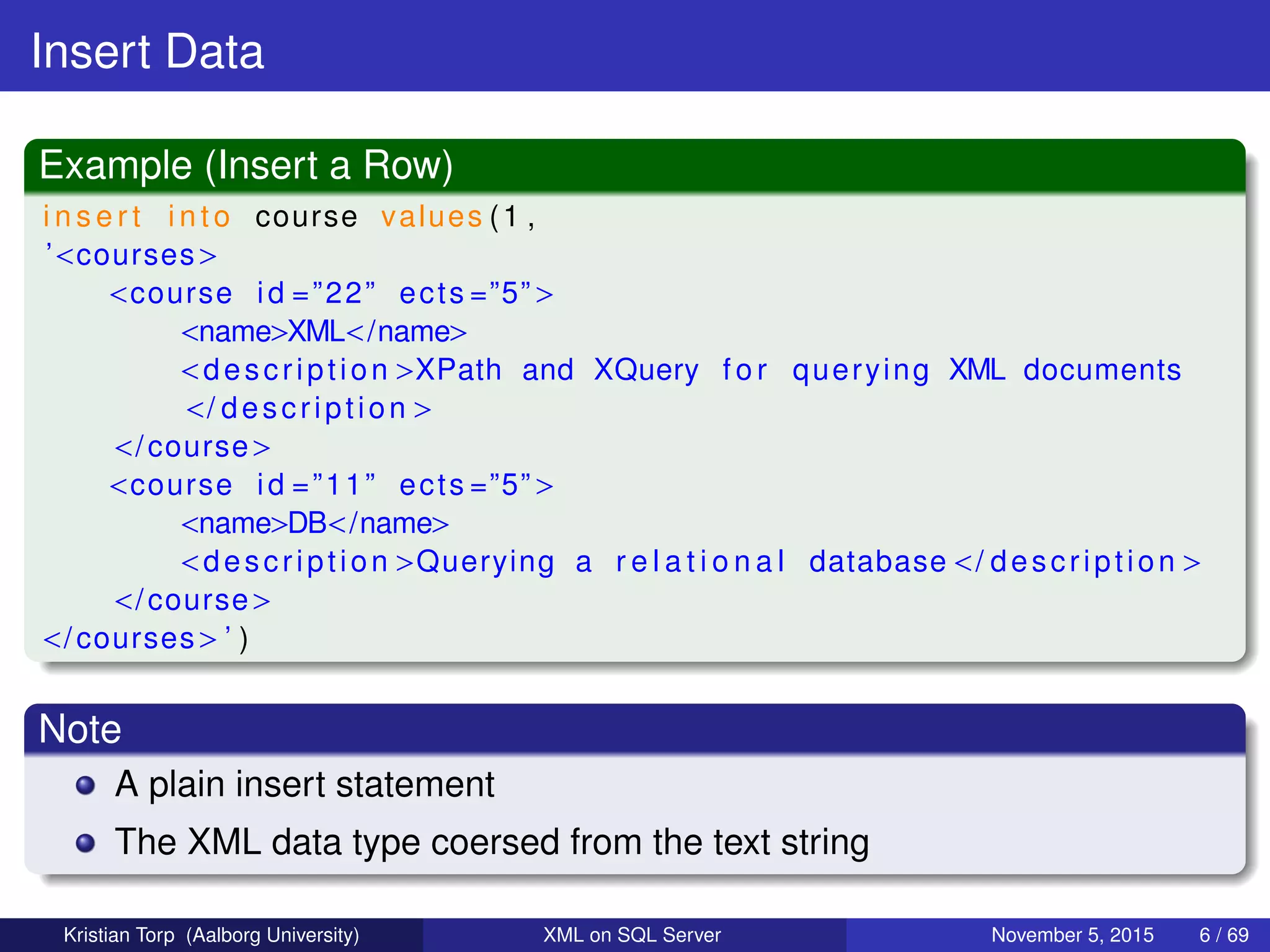
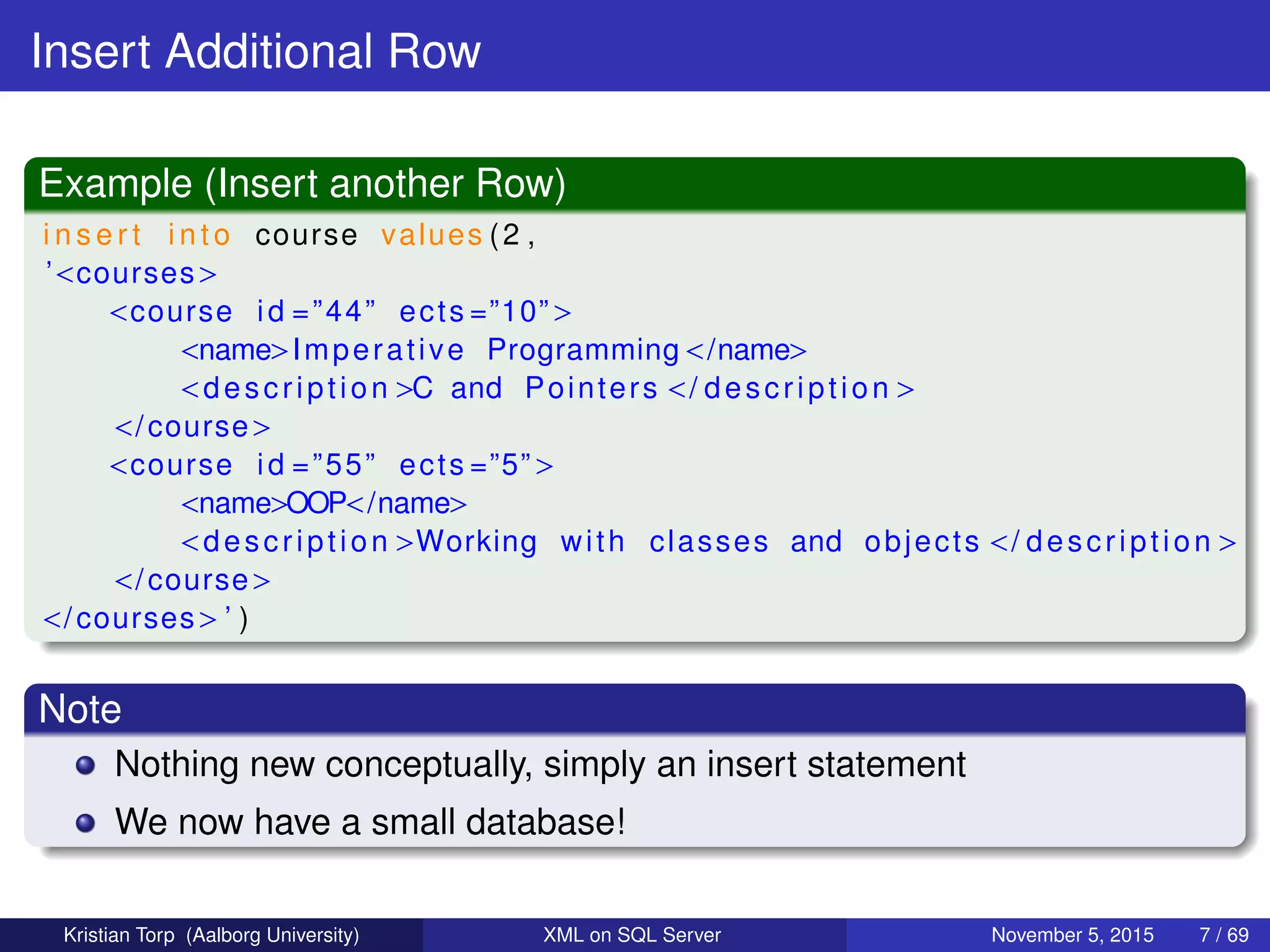
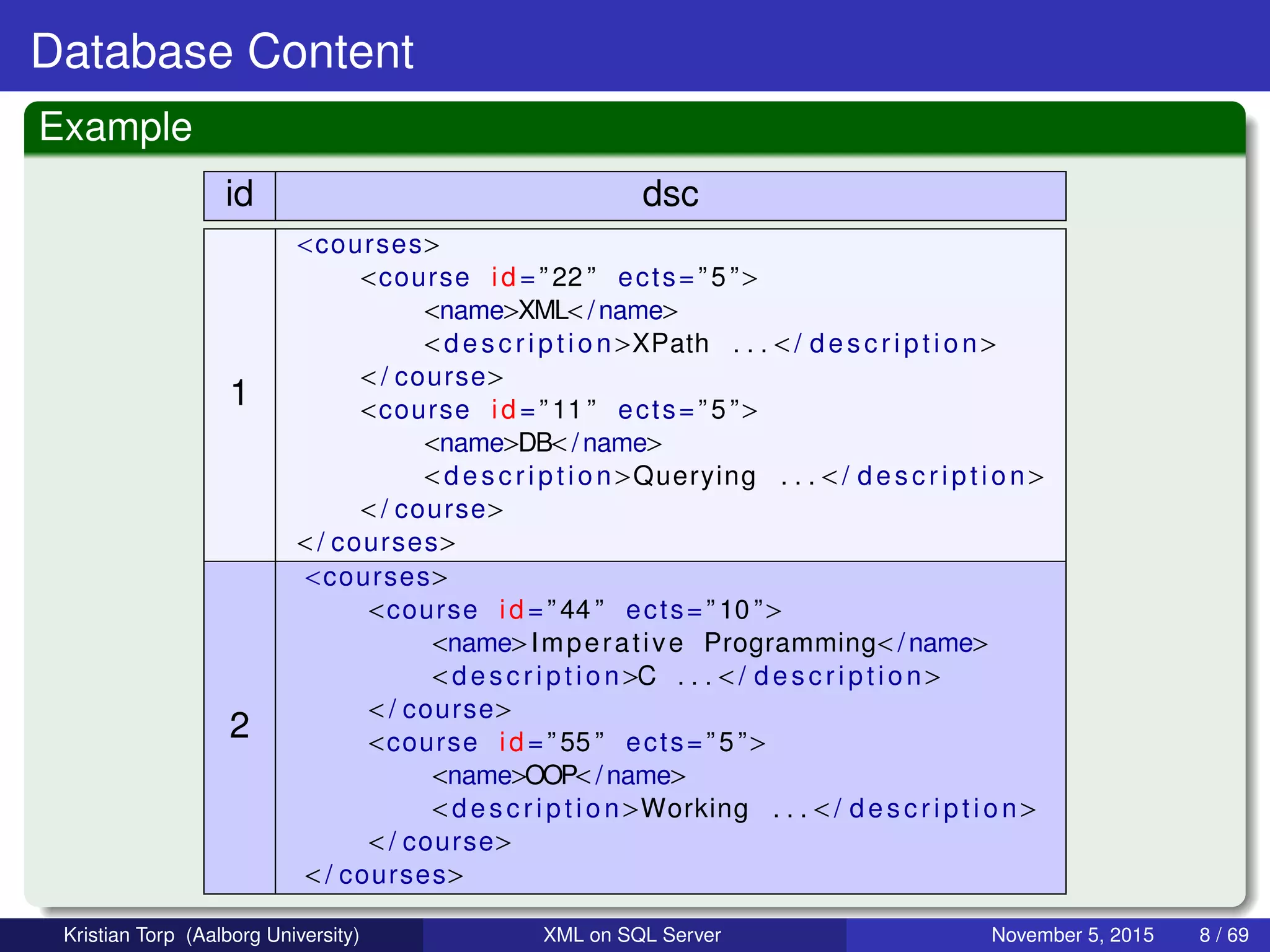
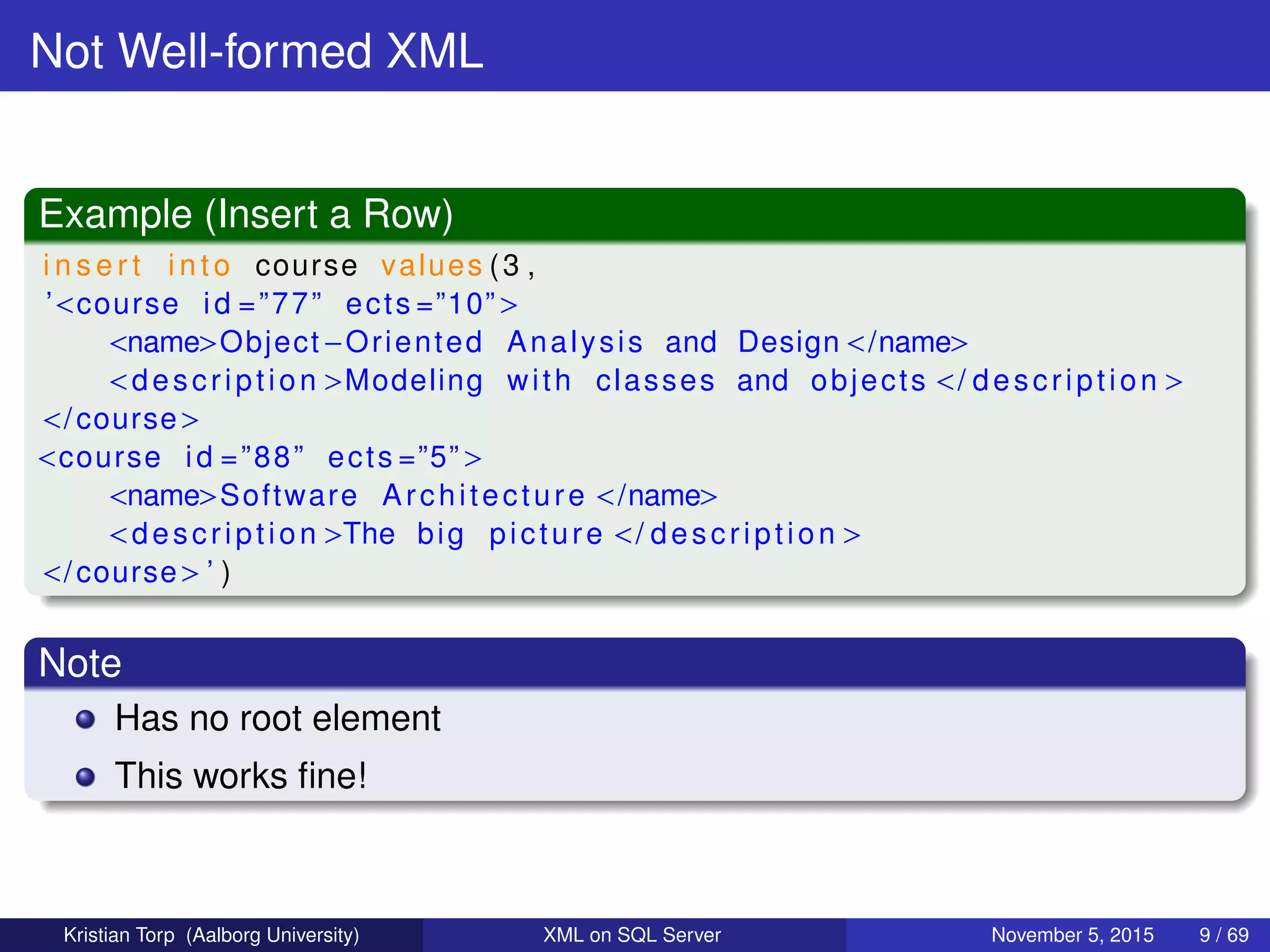
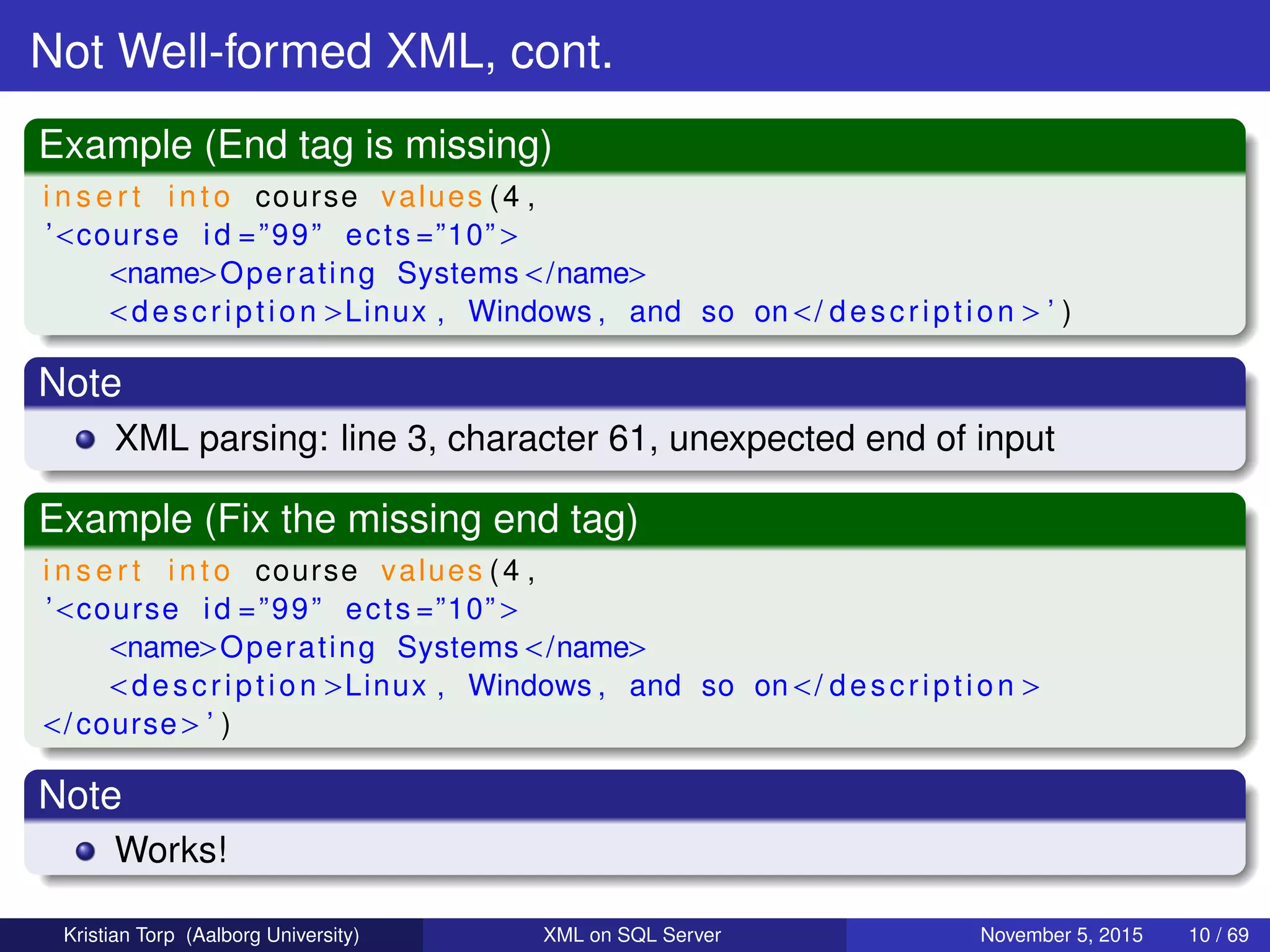
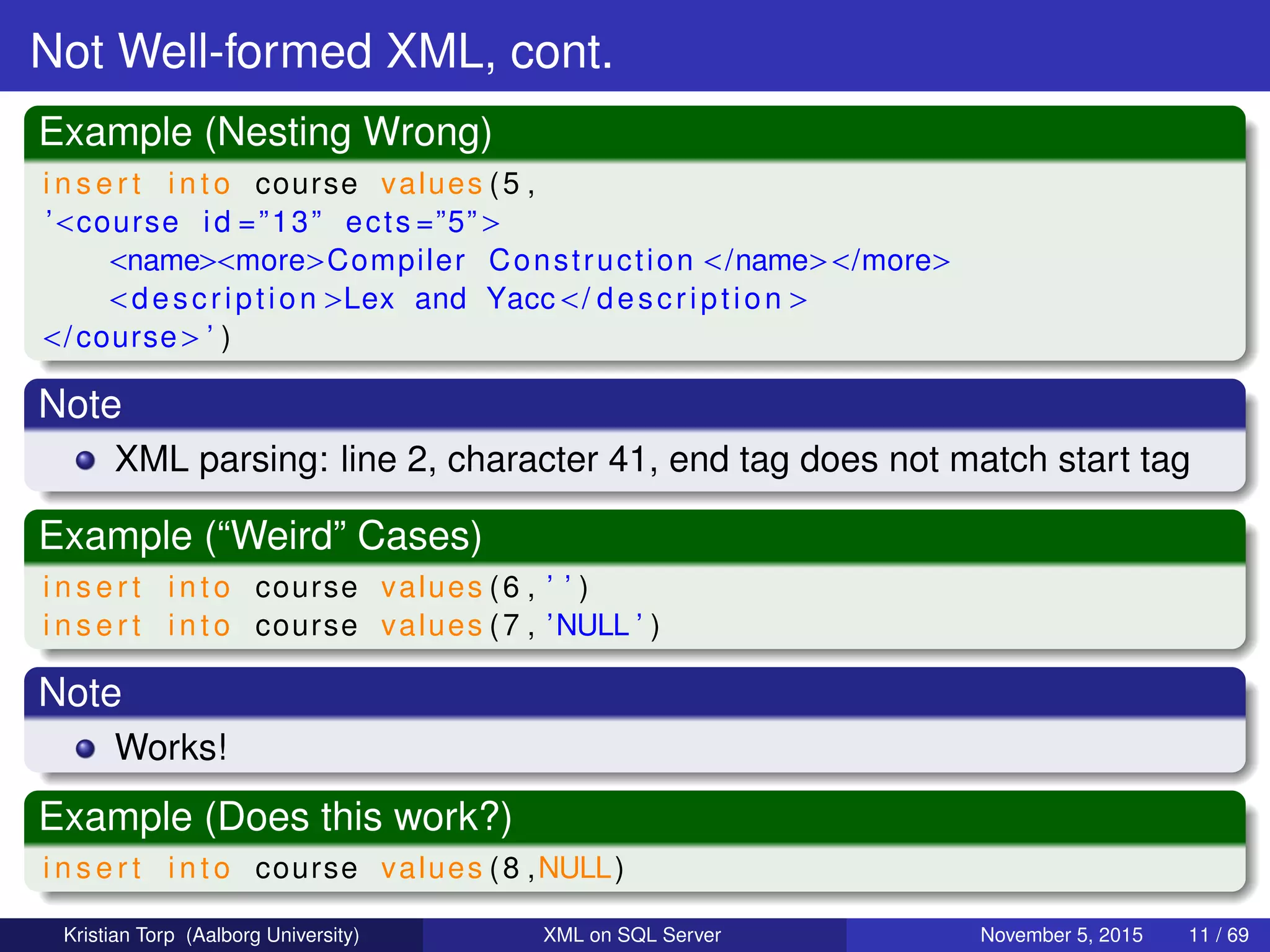
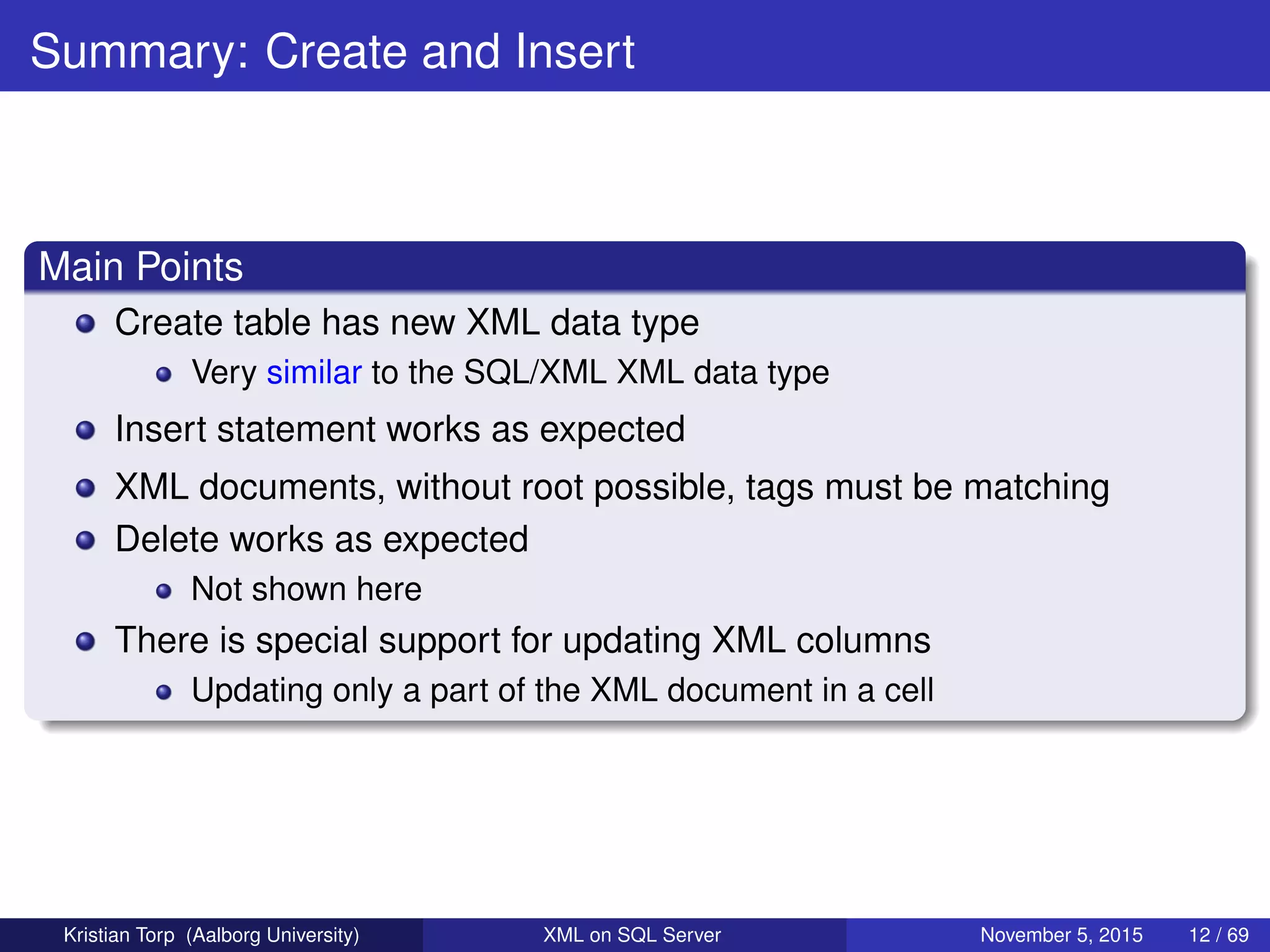
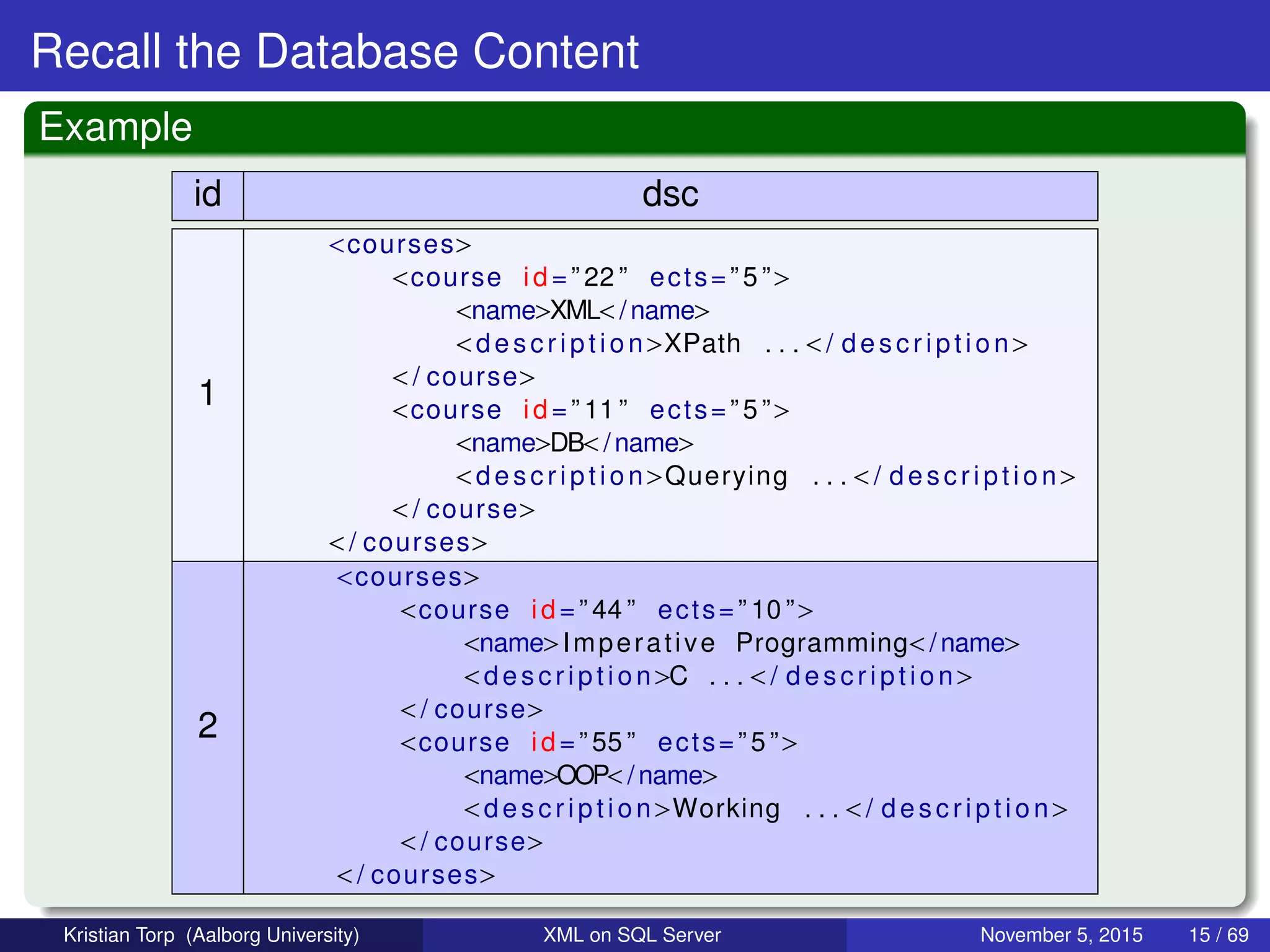
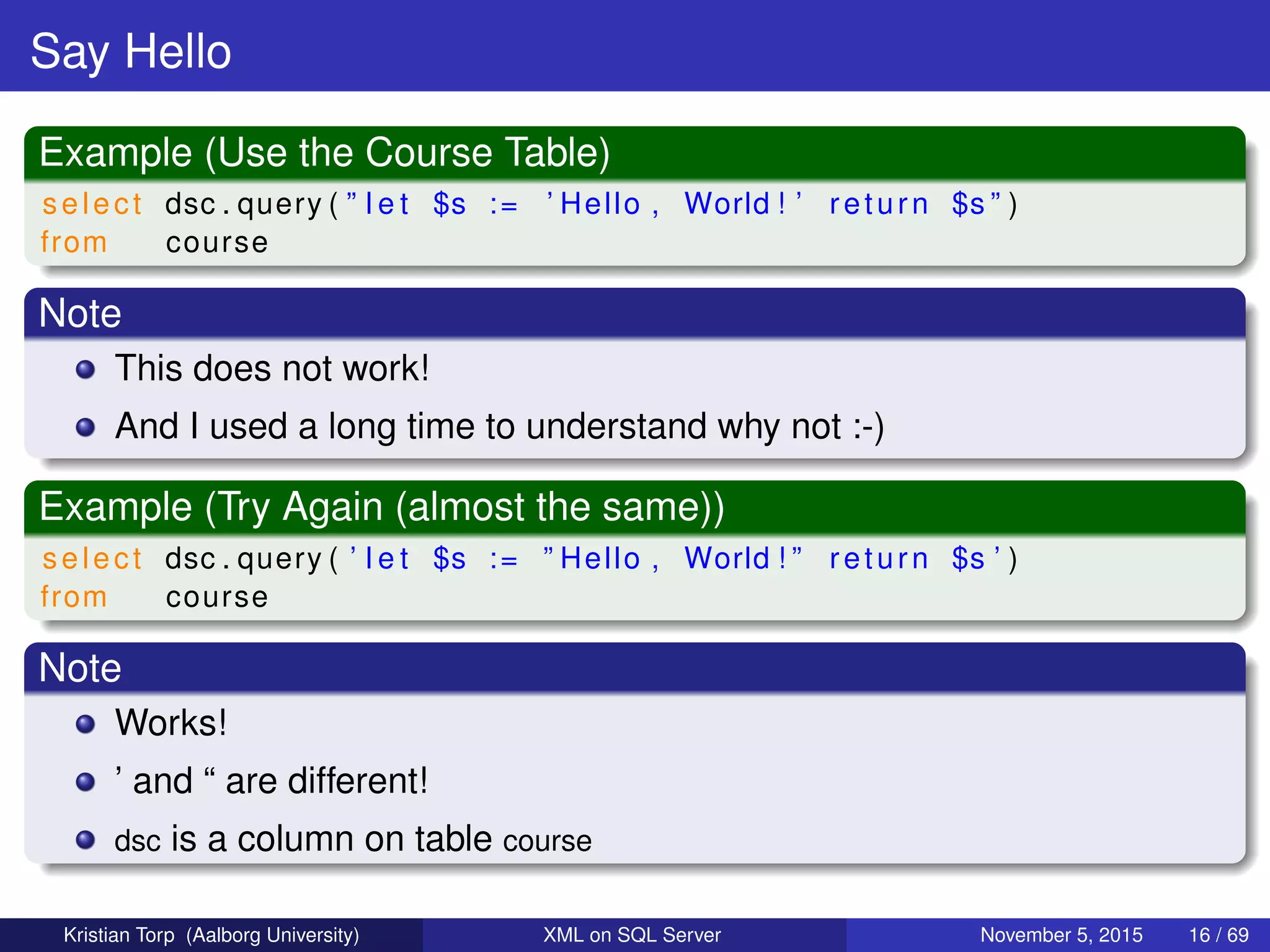
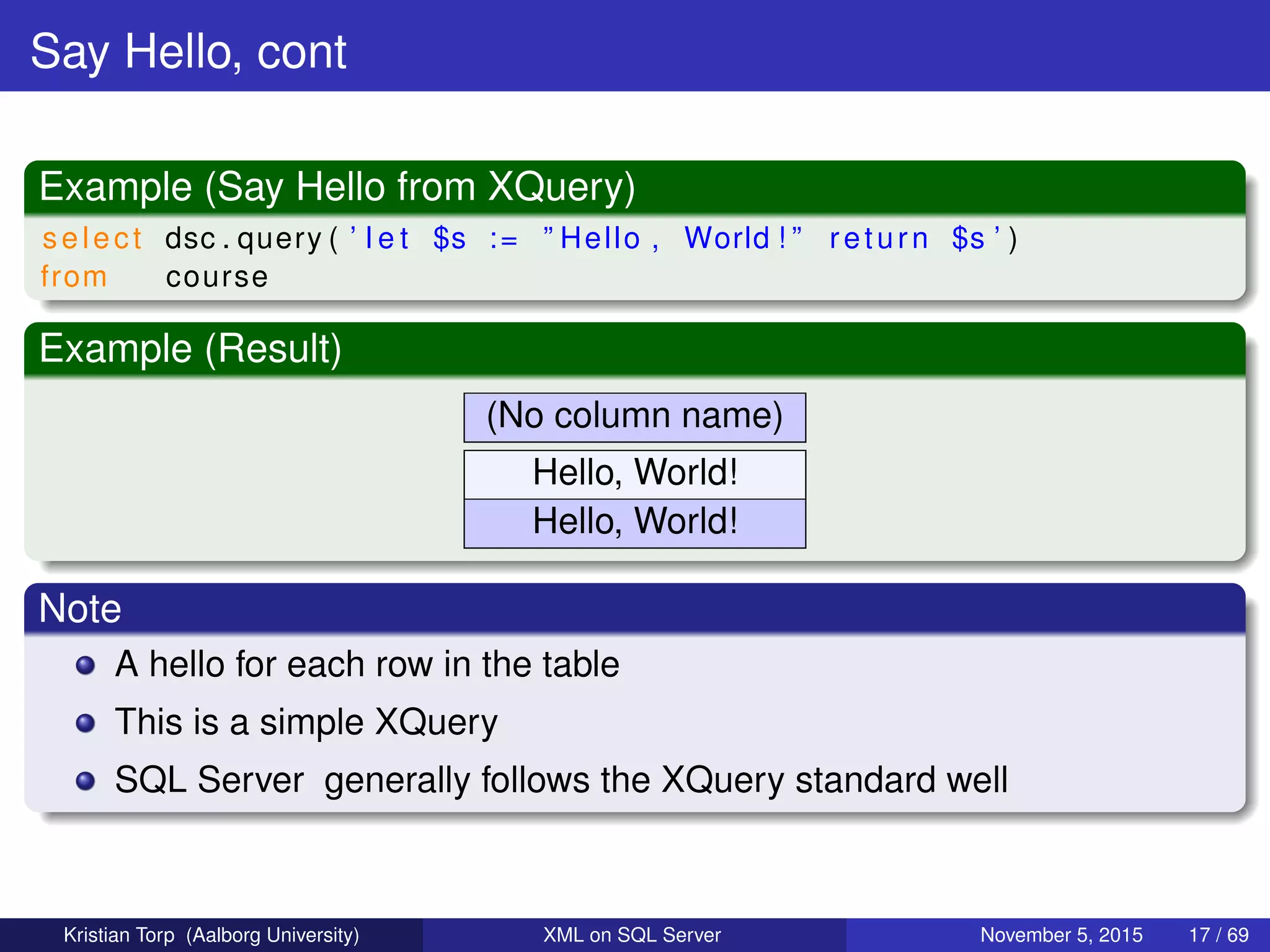
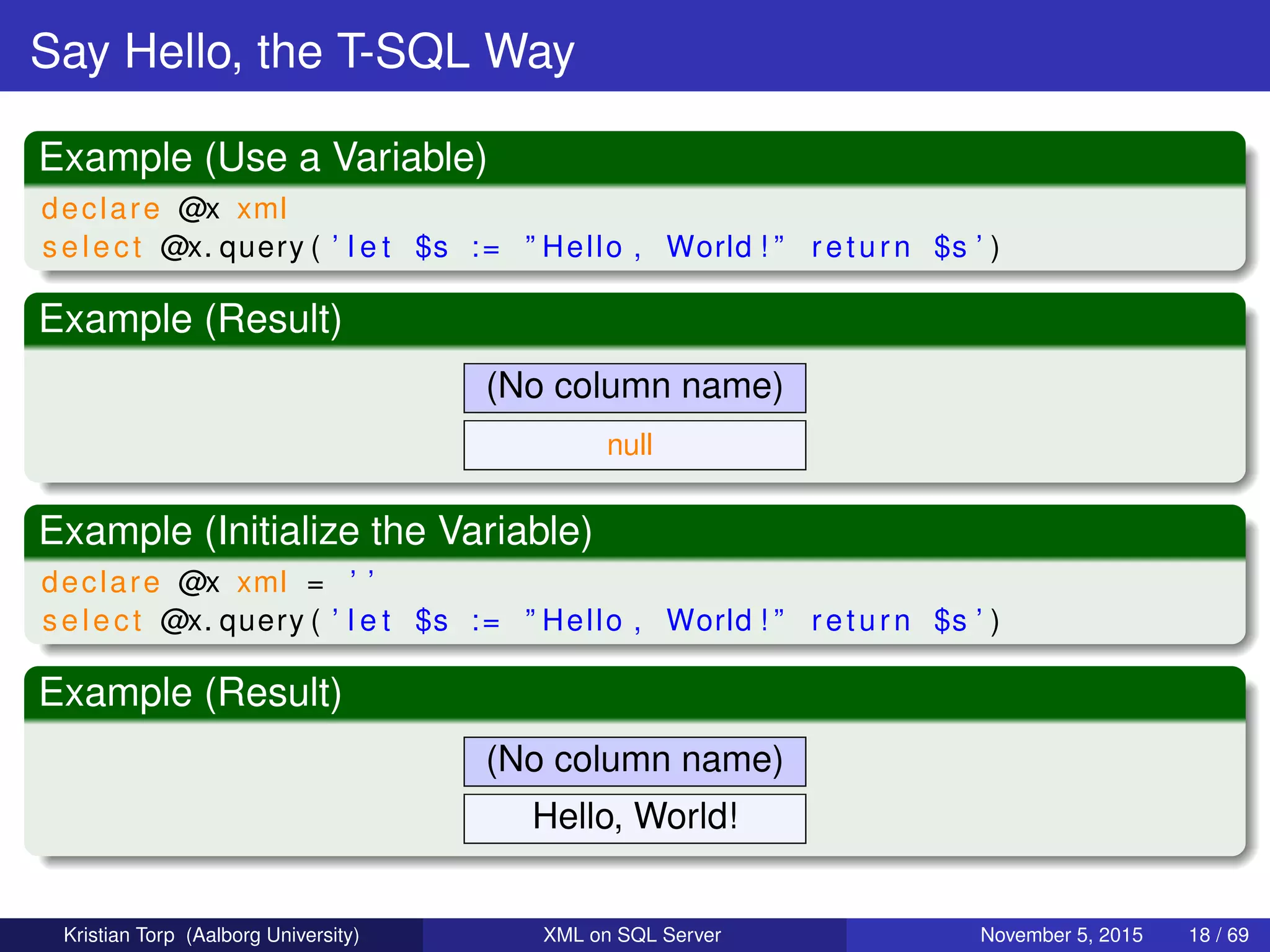
![Document IDs with more than 5 ECTS Courses Example (Use exist() in where ) select id from course where dsc . e x i s t ( ’ / / course [ @ects > 5] ’ ) Note An expression of non-boolean type specified in a context where a condition is expected, near ’)’ Example (Use exist() in select ) select id , dsc . e x i s t ( ’ / / course [ @ects > 5] ’ ) from course Example (Result) id (No column name) 1 0 2 1 Kristian Torp (Aalborg University) XML on SQL Server November 5, 2015 20 / 69](https://image.slidesharecdn.com/xmlsqlserver-151105181103-lva1-app6891/75/XML-on-SQL-Server-16-2048.jpg)
![Retrying Document IDs with more than 5 ECTS Courses Example (Use exist() in where ) select id from course where dsc . e x i s t ( ’ / / course [ @ects > 5] ’ ) = 1 Example (Result) id 2 Note exist() returns 0, 1 or null This is a surprise! (when used to other DBMSs) Kristian Torp (Aalborg University) XML on SQL Server November 5, 2015 21 / 69](https://image.slidesharecdn.com/xmlsqlserver-151105181103-lva1-app6891/75/XML-on-SQL-Server-17-2048.jpg)
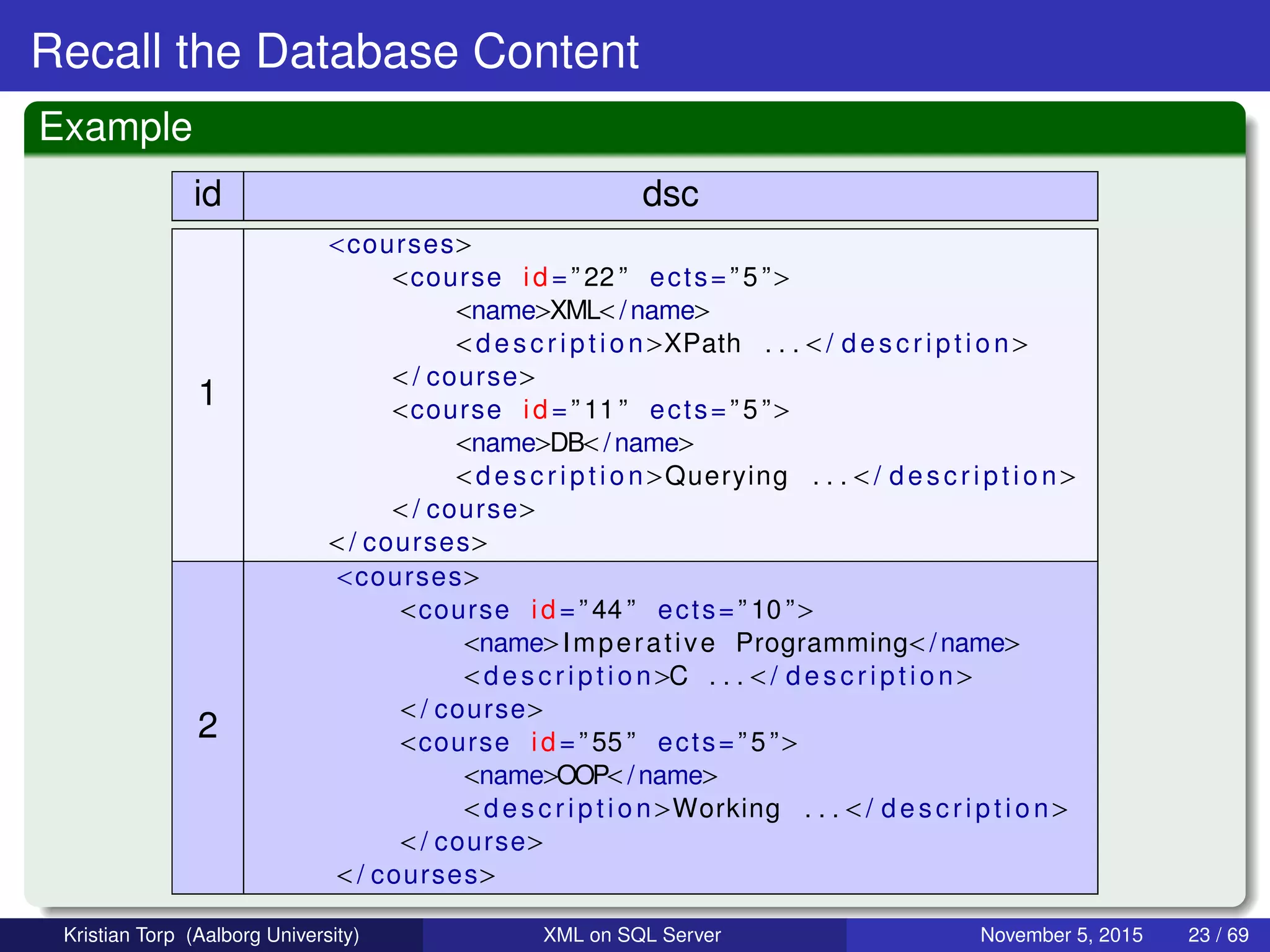
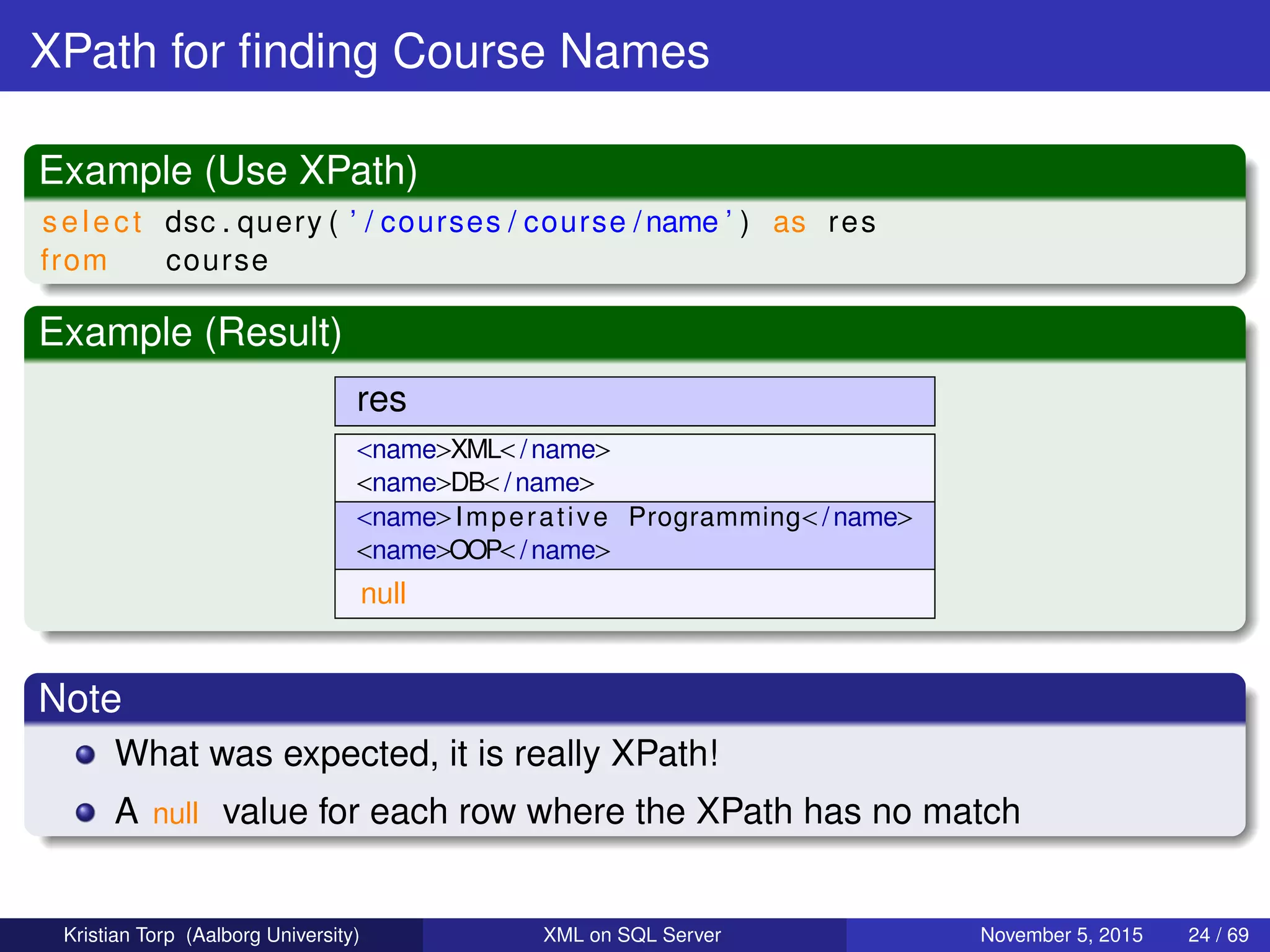
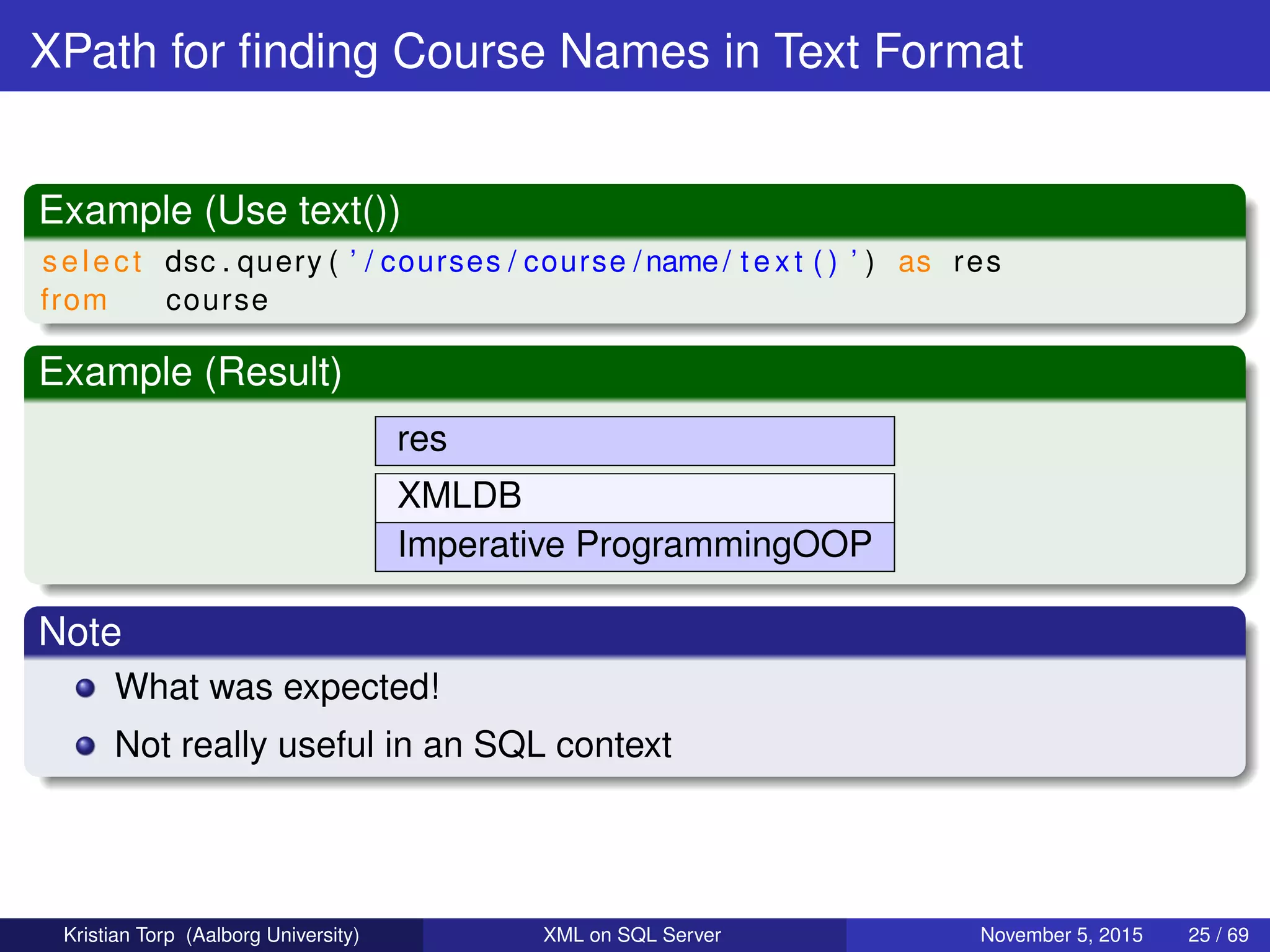
![Accessing Attributes Example (Look at Attributes) select dsc . query ( ’ / courses / course / @ects ’ ) as res from course Note XQuery [course.dsc.query()]: Attribute may not appear outside of an element Unexpected! Example (Look at Attributes) select dsc . query ( ’sum ( / courses / course / @ects ) ’ ) as res from course Example (Result) res 10 15 Kristian Torp (Aalborg University) XML on SQL Server November 5, 2015 26 / 69](https://image.slidesharecdn.com/xmlsqlserver-151105181103-lva1-app6891/75/XML-on-SQL-Server-21-2048.jpg)
![More XPath Example (Find 5 ECTS Courses) select dsc . query ( ’ / courses / course [ @ects =5]/name/ t e x t ( ) ’ ) as res from course Example (Result) res XMLDB OOP Example (Filtering using where ) select dsc . query ( ’ / / course /name/ t e x t ( ) ’ ) as res from course where id = 1 Example (Result) res XMLDB Kristian Torp (Aalborg University) XML on SQL Server November 5, 2015 27 / 69](https://image.slidesharecdn.com/xmlsqlserver-151105181103-lva1-app6891/75/XML-on-SQL-Server-22-2048.jpg)
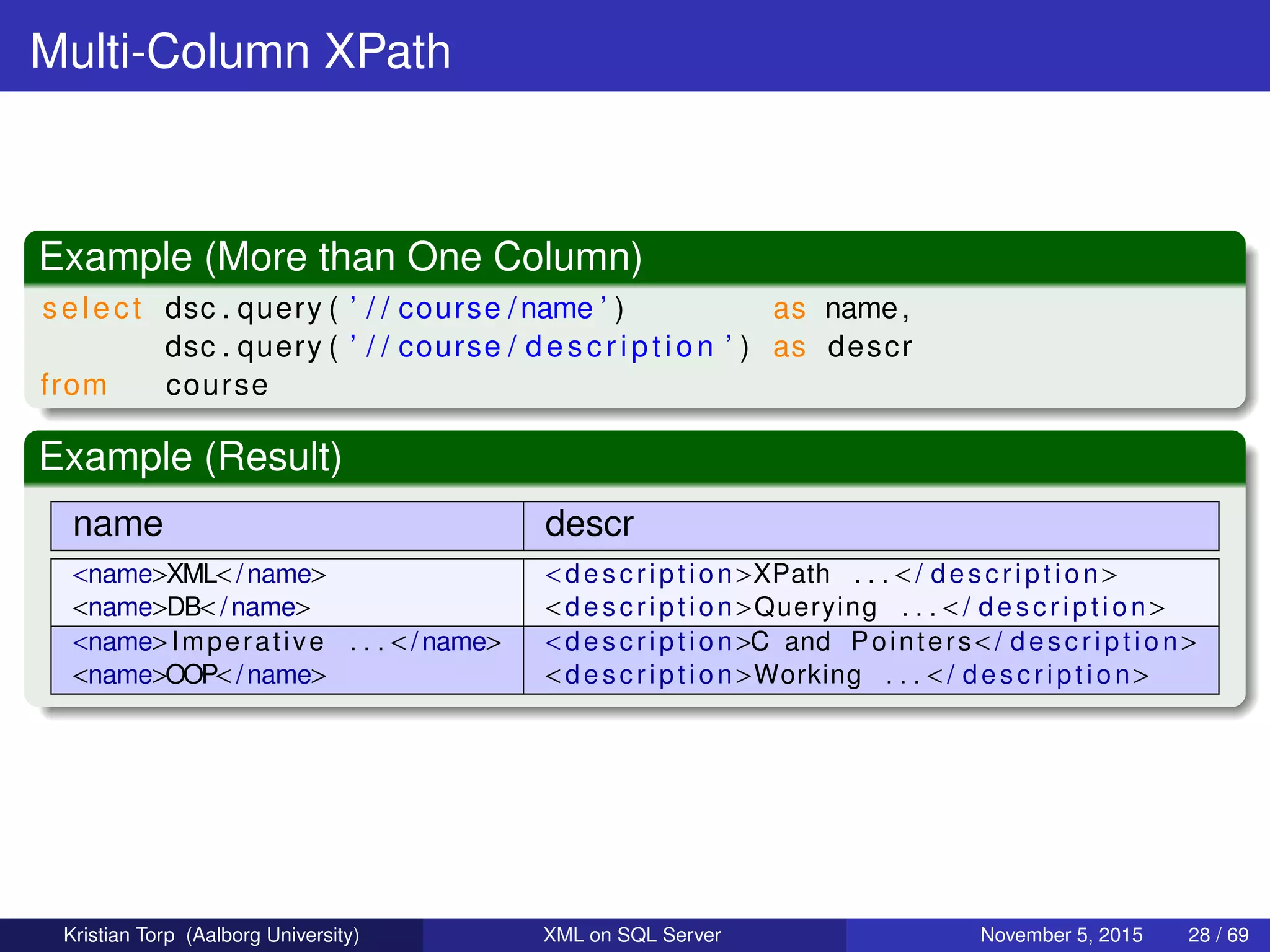
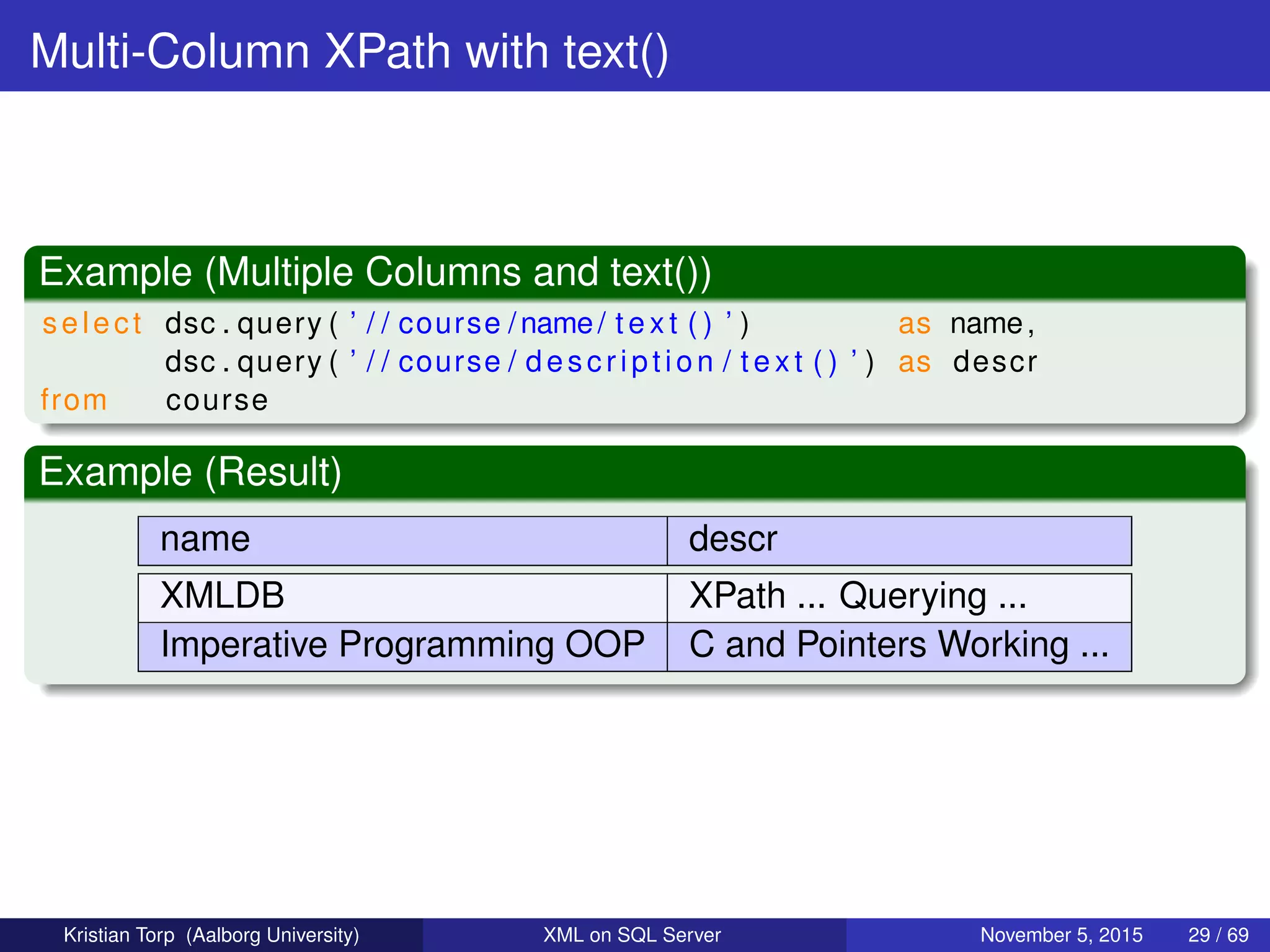
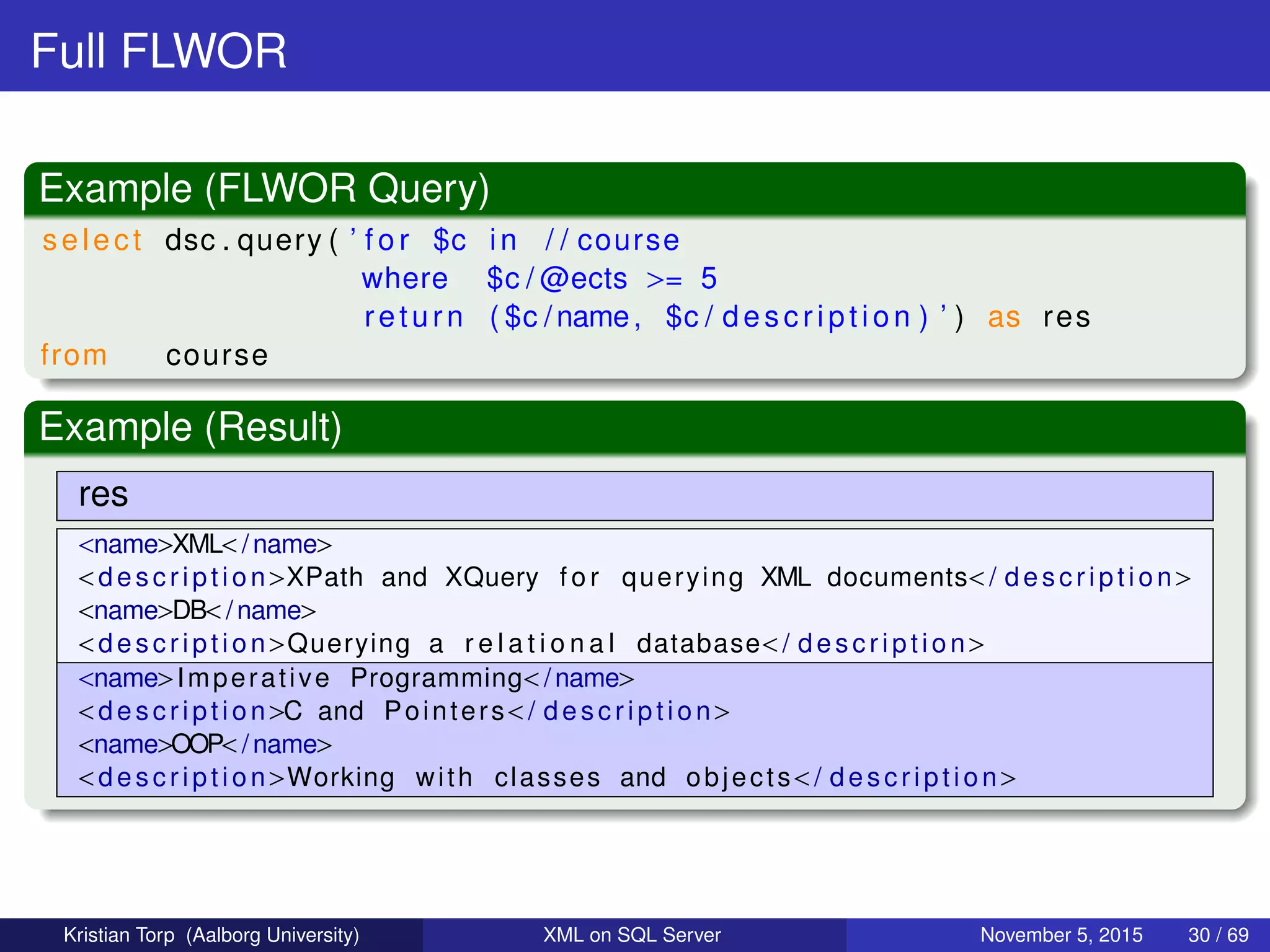
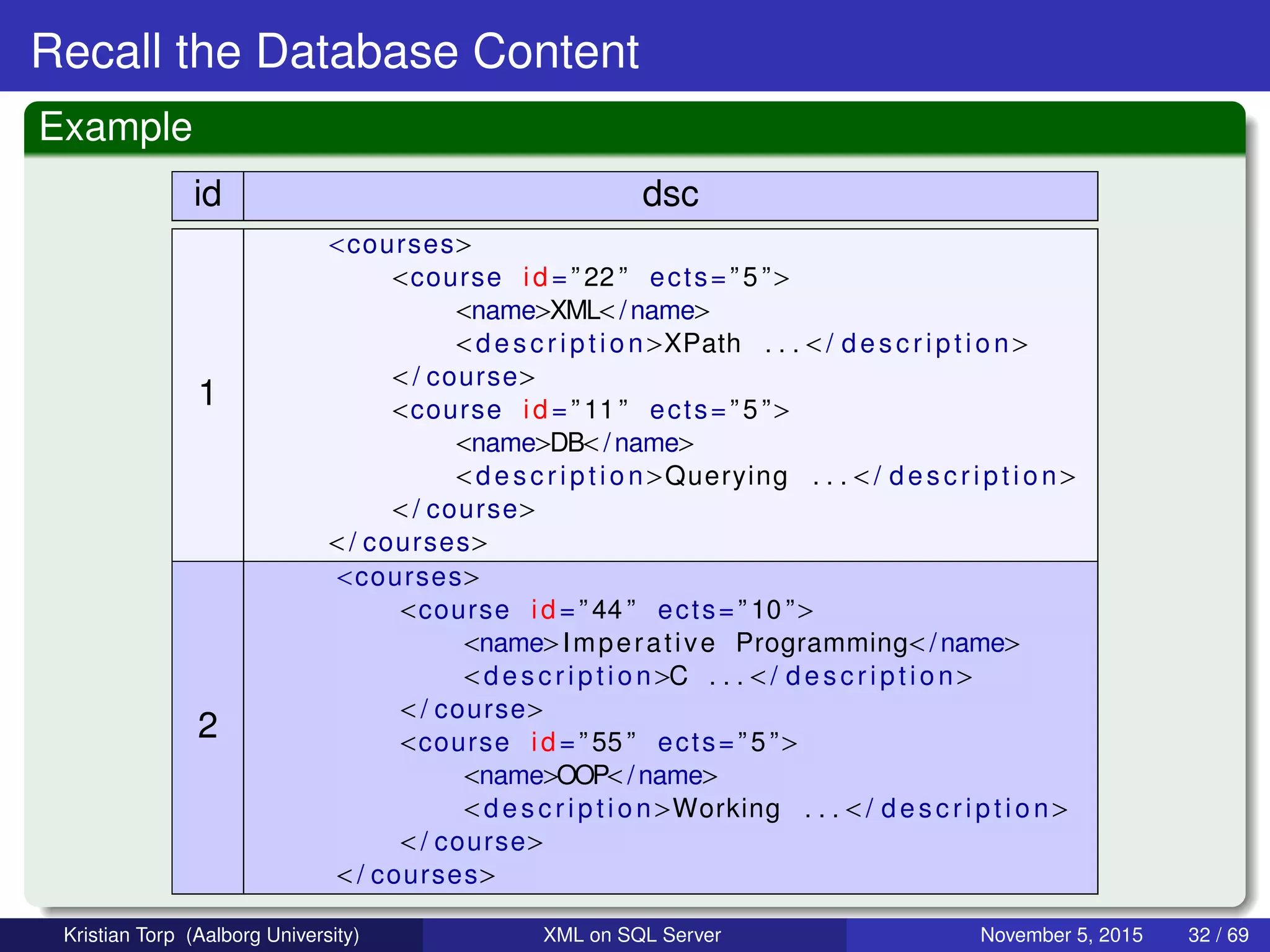
![Get Course Names in a Relational Fashion Example (Using the value() Function) select dsc . value ( ’ / / course /name ’ , ’ nvarchar (30) ’ ) from course Note XQuery [course.dsc.value()]: ’value()’ requires a singleton (or empty sequence), found operand of type ’xdt:untypedAtomic *’ Example (Singleton’ing) select dsc . value ( ’ ( / / course /name ) [ 1 ] ’ , ’ nvarchar (30) ’ ) from course Example (Result) (No column name) XML Imperative Programming Kristian Torp (Aalborg University) XML on SQL Server November 5, 2015 33 / 69](https://image.slidesharecdn.com/xmlsqlserver-151105181103-lva1-app6891/75/XML-on-SQL-Server-27-2048.jpg)
![Retrying Get Course Names in a Relational Fashion Example (First) select dsc . value ( ’ ( / / course [ 1 ] / name ) [ 1 ] ’ , ’ nvarchar (30) ’ ) from course Example (Result) (No column name) XML Imperative Programming Example (Last) select dsc . value ( ’ ( / / course /name ) [ l a s t ( ) ] ’ , ’ nvarchar (30) ’ ) from course Example (Result) (No column name) DB OOP Kristian Torp (Aalborg University) XML on SQL Server November 5, 2015 34 / 69](https://image.slidesharecdn.com/xmlsqlserver-151105181103-lva1-app6891/75/XML-on-SQL-Server-28-2048.jpg)
![Value and Wrong SQL Data Type Example (First) select dsc . value ( ’ ( / / course /name ) [ 1 ] ’ , ’ nvarchar (30) ’ ) from course Example (Result) (No column name) XML Imperative Programming Example (Last) select dsc . value ( ’ ( / / course /name ) [ 1 ] ’ , ’ nvarchar (3) ’ ) from course Example (Result) (No column name) XML Imp Kristian Torp (Aalborg University) XML on SQL Server November 5, 2015 35 / 69](https://image.slidesharecdn.com/xmlsqlserver-151105181103-lva1-app6891/75/XML-on-SQL-Server-29-2048.jpg)
![value() and Wrong SQL Data Type, cont. Example (String as an Integer) select dsc . value ( ’ ( / / course /name ) [ 1 ] ’ , ’ i n t ’ ) from course Note Conversion failed when converting the nvarchar value ’XML’ to data type int. Example (Integer Attribute) select dsc . value ( ’ ( / / course / @ects ) [ 1 ] ’ , ’ i n t ’ ) from course Example (Result) (No column name) 5 10 Kristian Torp (Aalborg University) XML on SQL Server November 5, 2015 36 / 69](https://image.slidesharecdn.com/xmlsqlserver-151105181103-lva1-app6891/75/XML-on-SQL-Server-30-2048.jpg)
![Flattening using value() Example (String as an Integer) select id , dsc . value ( ’ ( / / course / @ects ) [ 1 ] ’ , ’ i n t ’ ) as ects from course where dsc . e x i s t ( ’ / / course [ @ects > 5] ’ ) = 1 Example (Result) id ects 2 10 Note Using value() and exist() functions in same query Still too few rows Kristian Torp (Aalborg University) XML on SQL Server November 5, 2015 37 / 69](https://image.slidesharecdn.com/xmlsqlserver-151105181103-lva1-app6891/75/XML-on-SQL-Server-31-2048.jpg)
![Flattening using value(), cont Example (String as an Integer) select dsc . value ( ’ ( / / course / @id ) [ l a s t ( ) ] ’ , ’ i n t ’ ) as cid , dsc . value ( ’ ( / / course /name ) [ l a s t ( ) ] ’ , ’ nvarchar (30) ’ ) as cname , dsc . value ( ’ ( / / course / description ) [ l a s t ( ) ] ’ , ’ nvarchar (50) ’ ) as dsc . value ( ’ ( / / course / @ects ) [ l a s t ( ) ] ’ , ’ i n t ’ ) as ects from course Example (Result) cid cname dsc ects 11 DB Querying... 5 55 OOP Working... 5 Note Pure relational world result Result only has two rows (should have four) value() cannot be used must use nodes() Kristian Torp (Aalborg University) XML on SQL Server November 5, 2015 38 / 69](https://image.slidesharecdn.com/xmlsqlserver-151105181103-lva1-app6891/75/XML-on-SQL-Server-32-2048.jpg)
![Flattening using nodes() Example (Flatten XML) select f l a t . course . value ( ’ ( . / @id ) [ 1 ] ’ , ’ i n t ’ ) as cid , f l a t . course . value ( ’ ( . / name ) [ 1 ] ’ , ’ varchar (50) ’ ) as cname , f l a t . course . value ( ’ ( . / description ) [ 1 ] ’ , ’ varchar (50) ’ ) as dsc , f l a t . course . value ( ’ ( . / @ects ) [ 1 ] ’ , ’ i n t ’ ) as ects from course cross apply dsc . nodes ( ’ / / course ’ ) f l a t ( course ) order by cid Example (Result) cid cname dsc ects 11 DB Querying... 5 22 XML XPath... 5 44 Imp. C and ... 10 55 OOP Working... 5 Note Relational view on XML data!!! Kristian Torp (Aalborg University) XML on SQL Server November 5, 2015 40 / 69](https://image.slidesharecdn.com/xmlsqlserver-151105181103-lva1-app6891/75/XML-on-SQL-Server-33-2048.jpg)
![Hide XML Example (Create a View on XML Data) create view coursexml flat as select f l a t . course . value ( ’ ( . / @id ) [ 1 ] ’ , ’ i n t ’ ) as cid , f l a t . course . value ( ’ ( . / name ) [ 1 ] ’ , ’ varchar (50) ’ ) as cname , f l a t . course . value ( ’ ( . / description ) [ 1 ] ’ , ’ varchar (50) ’ ) as dsc , f l a t . course . value ( ’ ( . / @ects ) [ 1 ] ’ , ’ i n t ’ ) as ects from course cross apply dsc . nodes ( ’ / / course ’ ) f l a t ( course ) Example (Query the View) select ∗ from coursexml flat where ects = 5 and cid > 20 order by cid Example (Result) cid cname dsc ects 22 XML XPath... 5 55 OOP Working... 5 Kristian Torp (Aalborg University) XML on SQL Server November 5, 2015 41 / 69](https://image.slidesharecdn.com/xmlsqlserver-151105181103-lva1-app6891/75/XML-on-SQL-Server-34-2048.jpg)
